Back to Don's Maps
 Back to Archaeological Sites
Back to Archaeological Sites
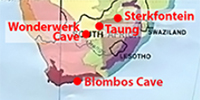 Hominid sites in Africa, including Homo sapiens
Hominid sites in Africa, including Homo sapiens
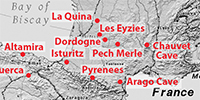 Hominid sites in Europe, including Homo sapiens
Hominid sites in Europe, including Homo sapiens
Hominin Overview
Hominids or Hominins?
The most commonly used recent definitions are:
Hominid – the group consisting of all modern and extinct Great Apes (that is, modern humans, chimpanzees, gorillas and orang-utans plus all their immediate ancestors).
Hominin – the group consisting of modern humans, extinct human species and all our immediate ancestors (including members of the genera Homo, Australopithecus, Paranthropus and Ardipithecus).
Definition above: https://australianmuseum.net.au/
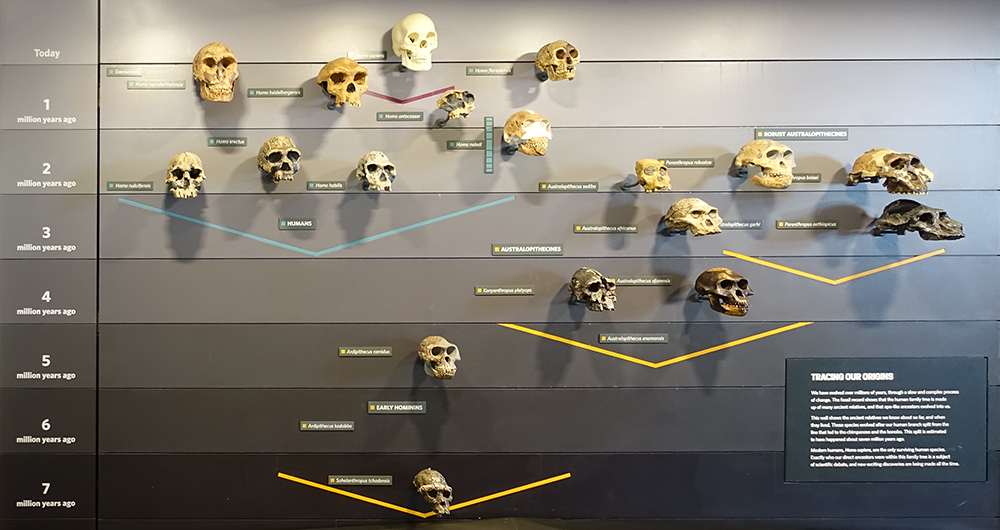
Tracing our origins - an overview of Hominins
Source and text: Display at The Natural History Museum, Cromwell Road, London
We have evolved over millions of years, through a slow and complex process of change. The fossil record shows that the human family tree is made up of many ancient relatives, and that ape-like ancestors evolved into us.
This wall shows the ancient relatives we know about so far, and when they lived. These species evolved after our human branch split from the line that led to the chimpanzee and the bonobo. This split is estimated to have happened about seven million years ago.
Sahelanthropus tchadensis
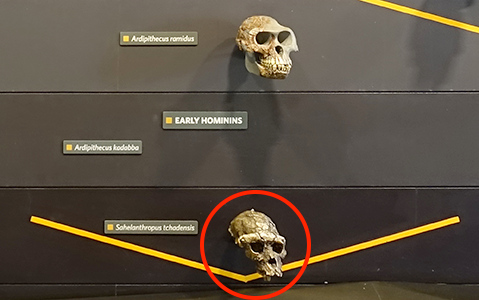
Sahelanthropus tchadensis
All fossils of this species have been recovered from Toros-Menalla in the Djurab desert of Chad, Africa.
Age has been established as 7 000 000 BP - 6 000 000 BP. This is a key date, as it is about the time that scientists believe the human line diverged from the ape line. The site lacked volcanic ash layers so was not suited to using radiometric dating techniques. Faunal analysis was used instead. This was possible because many of the fossil animals found at the site were identical to specimens that had been radiometrically dated elsewhere.
Dimensions: 183 x 105 x 97 mm.
Discovered in 2001 by Alain Beauvilain, Fanone Gongdibe, Mahamat Adoum and Ahounta Djimdoumalbaye, the original is now located at Musée National N'Djamena, N'Djamena (Chad), BEAC.
Photo (left): Don Hitchcock 2018
Source (left): Facsimile, display at The Natural History Museum, Cromwell Road, London
Photo (right): Didier Descouens
Source (right): Specimen of of Anthropology Molecular and Imaging Synthesis of Toulouse, described as the cast of the Sahelanthropus tchadensis holotype cranium TM 266-01-060-1, dubbed Toumaï, in facio-lateral view.
Permission: This file is licensed under the Creative Commons Attribution-Share Alike 4.0 International license. This file is copyrighted and has been released under a license which is incompatible with Facebook's licensing terms. It is not permitted to upload this file to Facebook.
Text: Adapted from https://australianmuseum.net.au/
Additional text: Wikipedia
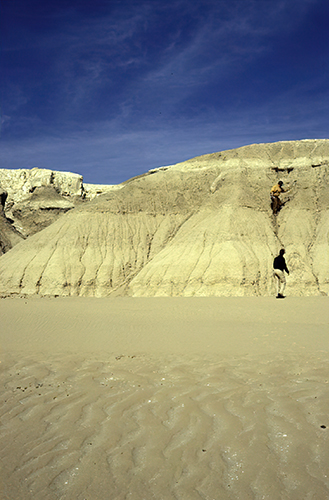
Djurab Desert.
Kouba Olanga, Northern Chad Basin, sampling site.
Photo: M. JolivetHistory
Source: Lebatard (2010)
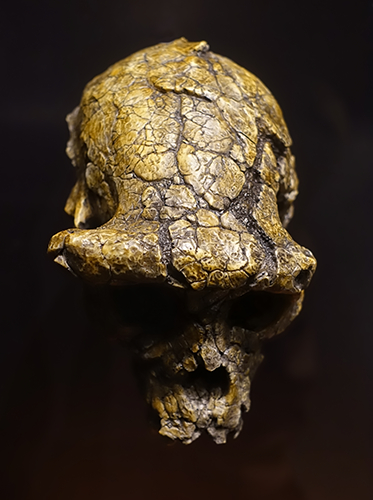
Sahelanthropus tchadensis
This may be the earliest hominin.
This species probably lived close to the time human ancestors and the ancestors of other apes split on the family tree. Like us, it has small canines and a flat face. However, it had a thick brow ridge and a small brain, more like a chimpanzee.
Photo: Don Hitchcock 2018
Catalog: TM 266-Q1-Q60-1, AQ PEG 2015 819
Source and text: Facsimile, display at The Natural History Museum, Cromwell Road, London
Original: in the Centre National D'appui À La Recherche, N'djamena Tchad, N'Djamena, Chad.
Ardipithecus kadabba
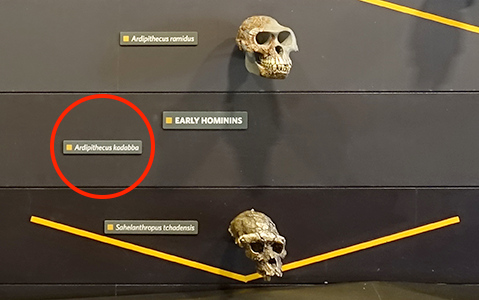
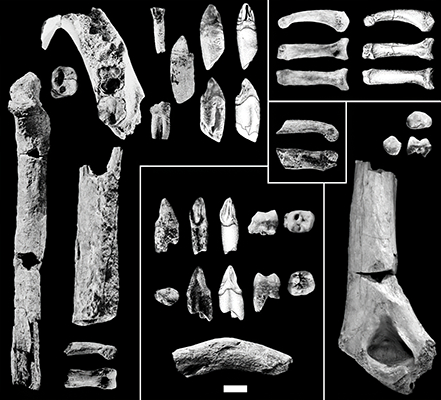
Ardipithecus kadabba
( I have not yet come across a report of a skull being found - Don )
Middle Awash Valley, Ethiopia, 5 800 000 BP - 5 200 000 BP, discovered in 1997.
Ape-like build- similar to modern chimpanzee in both size and build; large canines; human-like features include lack of canine honing and large molars, as well as big toe bone that suggests bipedalism.
Discovered in 1997 by Yohannes Haile-Selassie.
Catalog: Type specimen, ALA-VP-2/10
Source and text: Hominid Fossils, ANP 440 - Michigan State University, http://projects.leadr.msu.edu/hominidfossils/exhibits/show/pre-australopiths/item/81
Additional text: https://ipfs.io, at: http://tiny.cc/8wlncz
Resource: Haile-Selassie (2001)
Ardipithecus ramidus
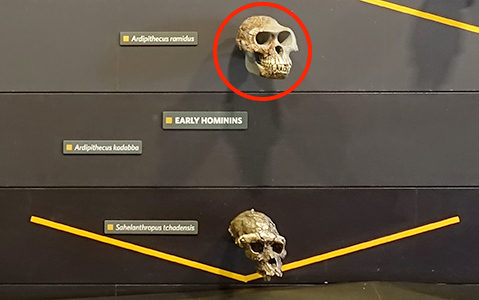
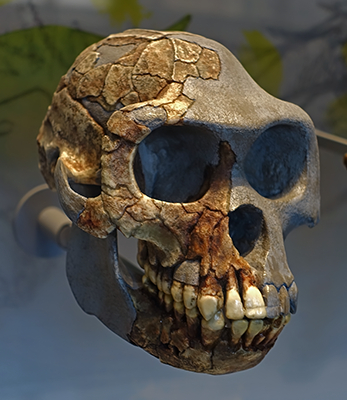
Ardipithecus ramidus
4 400 000 BP - 4 200 000 BP
Hundreds of pieces of fossilised bone were recovered during 1992-1994, by a team led by Yohannes Haile-Selassie, all from localities west of the Awash River, in Aramis, Ethiopia. The finds number over 110 specimens and represent about 35 individual members of this species. Most of the remains are dental, but some skull and limb bones were also found. A partial humerus (arm bone) indicates that this species was smaller than the average Australopithecus afarensis.
In 2005, the remains of 9 individuals were recovered from As Duma in northern Ethiopia. The remains mostly consist of teeth and jaw fragments, but also some bones from the hands and feet.
ARA-VP-6/1 teeth: This is the holotype for this species. It consists of teeth and jaw bone and was found in Aramis in 1993.
'Ardi' ARA-VP-6/500: A partial skeleton found in 1994, consisting of about 125 pieces, was described and published in 2009. It is the oldest known skeleton of a human ancestor. The individual is believed to be a female and is nicknamed 'Ardi'. She weighed about 50kg and stood about 120cm tall.The skeleton was in extremely poor condition and it took the team 15 years to excavate, scan, make virtual reconstructions, assemble and then analyse. The results were hugely significant in terms of how we view the evolution of the earliest hominins and the physical appearance of the last common ancestor of humans and chimpanzees. The skeleton does not look much like a chimp or gorilla or have the expected 'transitional' features. Instead, it may well preserve some of the characteristics of the last chimp-human ancestor. Analysis of the skeleton reveals that humans did not evolve from knuckle-walking apes, as was long believed.
Photo: Don Hitchcock 2018
Catalog: ARA-VP-6/1, ARA-VP-6/500, MRD-VP-1/1
Text: Adapted from https://australianmuseum.net.au/
Source: Facsimile, Vienna Natural History Museum, Naturhistorisches Museum Wien
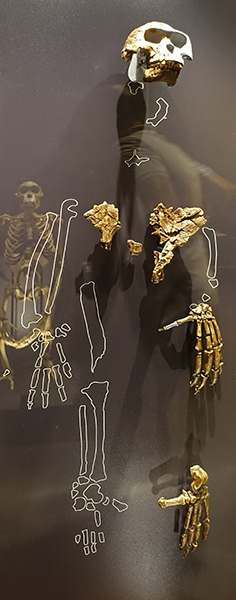
Ardipithecus ramidus
The oldest hominin skeleton
Scientists have found examples of almost every part of the skeleton of this small-brained species. Aspects of the pelvis and feet suggest that they could stand upright, but also climb. Uniquely shaped hands supported their body weight on their palms as the clambered through the trees, probably in woodland.
Photo: Don Hitchcock 2018
Catalog: Middle Awash, Ethiopia, about 4.3 - 4.5 million years old, ARA-VP-6/500, AQ PEG 2015 820
Source and text: Facsimile, display at The Natural History Museum, Cromwell Road, London
Original: in the National Museum of Ethiopia
Australopithecus anamensis
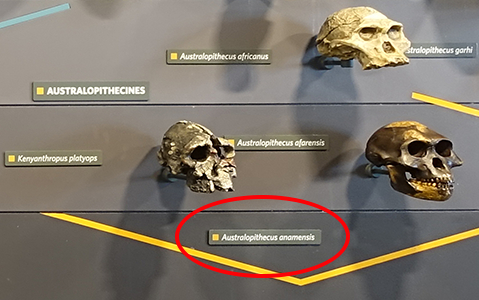
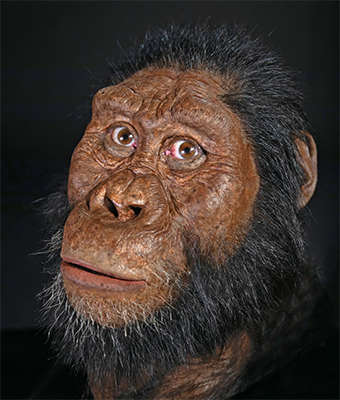
Australopithecus anamensis
3 800 000 BP
About 3.8 million years ago, a distant human relative took his final steps. Swept into a river delta, his head was buried in sand that, over time, hardened into a stone helmet. The skull fossilised within the sandstone, to the delight of the scientists who discovered the cranium in 2016.
Excavations at Woranso-Mille in Ethiopia, the site of an ancient river and lake system where anthropologists found the fossil, have produced a trove of bones from ancient primates. Yet this skull is 'one of the most significant specimens we've found so far' Yohannes Haile-Selassie, an anthropologist at the Cleveland Museum of Natural History and a member of the international team that studied the remains, told reporters on Tuesday.
The first piece of MRD, the upper jaw, was found by Ali Bereino (a local Afar worker) on February 10, 2016, at a locality known as Miro Dora, Mille District of the Afar Regional State. The specimen was exposed on the surface, and further investigation of the area resulted in the recovery of the rest of the cranium. 'I couldn't believe my eyes when I spotted the rest of the cranium. It was a eureka moment and a dream come true,' said Haile-Selassie.
The skull, probably a male's, is from a species called Australopithecus anamensis, as Haile-Selassie and his colleagues report in a pair of papers published Wednesday in the journal Nature. When compared with other ancient bones, the cranium could change how anthropologists view a critical point in the evolution of humanlike primates.
The primates sported a mixture of traits both primitive and humanlike. The species almost certainly walked on two legs, yet they had long arms and strong hands, suggesting they were capable climbers. The fossil is now at the National Museum in Addis Ababa, Ethiopia.
Photo (top left): Dale Omori/Cleveland Museum of Natural History
Proximal source and text: https://www.washingtonpost.com/
Additional text: https://www.science20.com/news_staff/the_face_of_lucys_ancestor_38_million_years_ago-241172
Photo (top right): unattributed, possibly also Dale Omori/Cleveland Museum of Natural History
Proximal source: https://theconversation.com/how-the-skull-of-humanitys-oldest-known-ancestor-is-changing-our-understanding-of-evolution-122926
Photo (bottom left): Matt Crow, courtesy of the Cleveland Museum of Natural History. Facial reconstruction by John Gurche made possible through generous contribution by Susan and George Klein
Proximal source: https://theconversation.com/how-the-skull-of-humanitys-oldest-known-ancestor-is-changing-our-understanding-of-evolution-122926
Resource: Saylor et al. (2019)
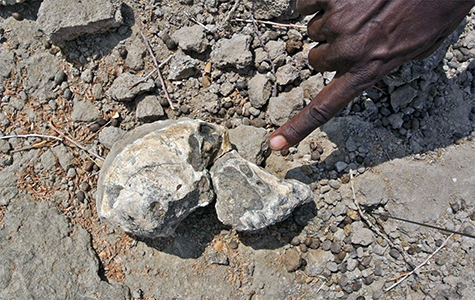
Australopithecus anamensis in situ.
( This skull has the scientific identification label 'MRD-VP-1/1', usually shortened to the label 'MRD' - Don )
The cranium was discovered in 2016 at Miro Dora, Mille district of the Afar Regional State in Ethiopia.
Photo: © Yohannes Haile-Selassie, Cleveland Museum of Natural History
Source: https://www.eurekalert.org/pub_releases/2019-08/mpif-aff082519.php
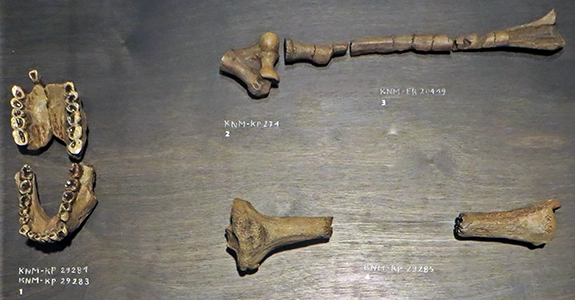
Photo above: Ghedoghedo
Permission: Creative Commons Attribution-Share Alike 4.0 International license
Source: Royal Belgian Institute of Natural Sciences, Brussels 2015
________
Data concerning the specimens pictured above:
________
Australopithecus anamensis, KNM-KP 29281
1
KNM-KP 29281 is an adult mandible that includes all teeth, but lacks the rami. The teeth show canines that have long and very robust roots, and thick molar enamel. This specimen reflects similarities to older fossil specimens from Laetoli in the size of the canines, as well as the flare of the molars and the vertically implanted maxillary canines.
Site: Kanapoi, Kenya, 1994
Date: 4 100 000 BP
Text: http://efossils.org/page/boneviewer/Australopithecus%20anamensis/KNM-KP%2029281
________
Australopithecus anamensis, KNM-KP 29283
KNM-KP 29283 is a nearly complete adult maxilla that exhibits signs of weathering. Although the lateral incisors were recovered separately, nearly all teeth for the specimen are present except the left first incisor and the right third molar. The maxilla is broken into two halves along the midline, and articulates together anteriorly.
Discovered By: W. Mangao
Site: Kanapoi, Kenya, 1997
Date: 4 170 000 BP - 4 120 000 BP
Text: http://www.efossils.org/page/boneviewer/Australopithecus%20anamensis/KNM-KP%2029283
________
Australopithecus anamensis, KNM-KP 271
The distal end of a left humerus.
Site: Kanapoi, Kenya, 1965
Date: 4 000 000 BP
Dating: biostratigraphy of the sequence in which it was found, later confirmed with 40Ar/39Ar dating of the volcanic ash layer.
Text: http://projects.leadr.msu.edu/hominidfossils/items/show/43
________
Australopithecus anamensis, KNM-ER 20419
A nearly complete left radius was recovered from middle Pliocene sediments east of Lake Turkana, Kenya, in 1988.
Text: Heinrich et al. (1993)
________
Australopithecus anamensis, KNM-KP 29285
This 4.1 million year old upper tibia (shin bone) fossil, KNM-KP 29285, comes from Australopithecus anamensis, an early human species that lived near open areas and dense woods. Their bodies had evolved in ways that enabled them to walk upright most of the time while still being able to climb trees. As a result, they could take advantage of both habitats. The top part of the tibia (where the lower leg meets the knee) is concave, or depressed from stress. This shows that the individual often put weight on the bone—evidence of standing upright. The lower part of the tibia (where the lower leg meets the ankle) is wider or thicker—evidence that it acted as a type of shock absorber as this individual walked .
This specimen, which consists of the proximal and distal ends of a right tibia, provides the earliest evidence for bipedalism in Australopithecus anamensis. The proximal condyles, which articulate with the distal end of the femur, are concaved like the condyles seen in anatomically modern Homo sapiens. Additionally, similar to modern humans, the proximal tibia is wider near the knee joint to allow the deposit of extra spongy bone, which acts as a shock absorber during bipedal locomotion. This extra deposit of spongy bone can also be seen in the medial malleolus, which articulates with the ankle.
Overall, the partial tiba is more human-like than it is ape-like. The fact that the shock-absorbing mechanisms in Au. anamensis so closely mirror the same mechanisms seen in modern humans is what led Leakey, Kimeu, and other paloeanthropologists to believe that this species was a habitual biped.
Site: Kanapoi, Kenya, 1965
Date: 4 100 000 BP
Dating: 40Ar/39Ar dating of the volcanic ash layer in which it was found.
Text: https://humanorigins.si.edu/evidence/human-fossils/fossils/knm-kp-29285 and http://projects.leadr.msu.edu/hominidfossils/items/show/42
________
Kenyanthropus platyops
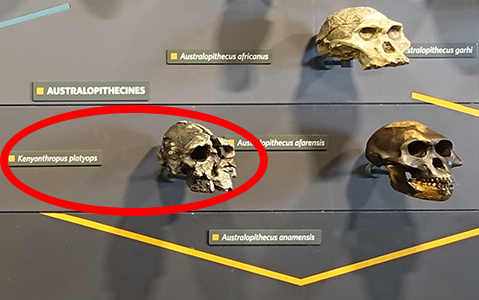
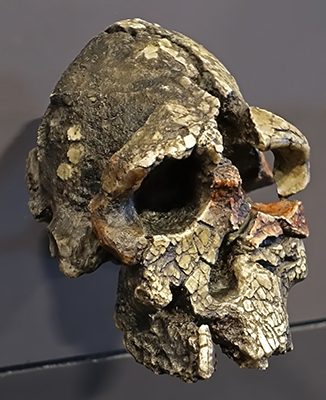
Kenyanthropus platyops
3 500 000 BP - 3 200 000 BP
Discovered at Lake Turkana, Kenya in 1999 by Justus Erus, who was part of Meave Leakey's team.
Leakey proposes that the fossil represents an entirely new hominin species and genus, while others classify it as a species of Australopithecus, Australopithecus platyops, others as a species of Homo, Homo platyops, and yet others interpret it as an individual of Australopithecus afarensis.
Fragments of a skull (KNM-WT 40000) and teeth were found in 1999 and reconstructed. Another specimen tentatively classified into this species is a partial left upper jaw (KNM-WT 38350), which was discovered in 1998.
The finders believe the skull shares similarities with a later species, Homo rudolfensis, including the relatively flat face and the lack of a depression behind the brow ridge, indicating it may be an ancestor of Homo. If this analysis is correct then it challenges the place of Australopithecus as a direct human ancestor. However, the acceptance of this new species is unresolved. Many experts argue that this skull was extremely distorted and has been badly reconstructed. They claim it is a Kenyan variant of Australopithecus afarensis.
More material needs to be recovered, especially a skull with no apparent distortion, in order to resolve this debate.
Photo: Don Hitchcock 2018
Catalog: KNM-WT 40000, KNM-WT 38350
Text: Adapted from https://australianmuseum.net.au/ and Wikipedia
Source: Facsimile, display at The Natural History Museum, Cromwell Road, London
Australopithecus afarensis
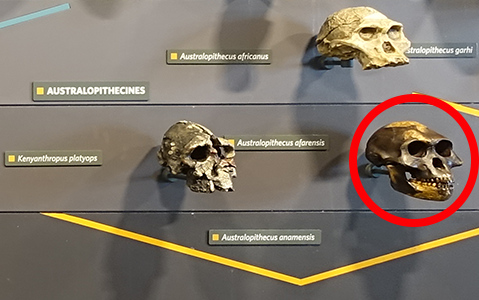
Australopithecus afarensis
3 900 000 BP - 2 800 000 BP
A.L. 442-2, Cranium, facsimile, Hadar, Ethiopia
This skull of a male is much bigger than the skull of Lucy and other females of this species, indicating that there was sexual dimorphism in this hominin.
This species is one of the best known of our ancestors due to a number of major discoveries including a set of fossil footprints and a fairly complete fossil skeleton of a female nicknamed 'Lucy'.
During the 1970s, two fossil hunting teams began uncovering evidence of ancient human ancestors in east Africa. One team, co-led by Donald Johanson, was working at Hadar in Ethiopia. The other team led by Mary Leakey, was over 1 500 kilometres away at Laetoli in Tanzania. Fossils discovered at the two sites were found to have very similar features and ages but they did not match the fossils of any species known at that time. A new species name, Australopithecus afarensis, was therefore created for them in 1978. This species is now represented by several hundred fossils from east Africa.
Photo: Don Hitchcock 2015
Source and text: Facsimile, Vienna Natural History Museum, Naturhistorisches Museum Wien
Additional text: https://australianmuseum.net.au/
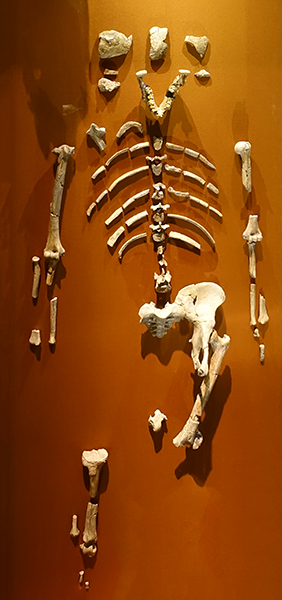
Australopithecus afarensis
3 200 000 BP
Lucy is the fossil that confirmed our ancient relatives walked upright. Her small skull, long arms and conical rib cage are like an ape's, but she has a more human-like spine, pelvis and knee. this capable tree-climber would have felt at home in both forested and more open environments.
Afar Triangle, Ethiopia
Photo: Don Hitchcock 2018
Catalog: AL-288-1, PA EM 4378
Source: Facsimile, display at The Natural History Museum, Cromwell Road, London
Original: in the National Museum of Ethiopia
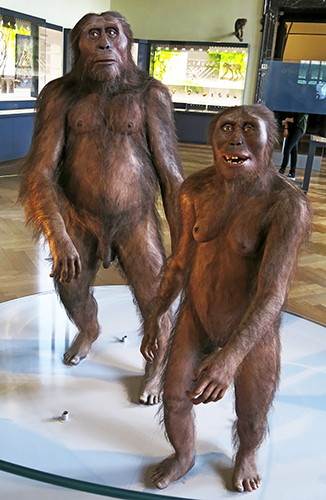
Australopithecus afarensis
Soft tissue reconstruction of a male (left) based on the fossil A.L. 444-2, Hadar, Ethiopia, ca 3 million years BP.
Soft tissue reconstruction of a female (right) based on the fossils A.L. 288 1 and A.L. 417, Hadar, Ethiopia, ca 3.2 million years BP.
Photo: Don Hitchcock 2015
Artist: Atelier Élisabeth Daynès, Paris
Source and text: Facsimile, Vienna Natural History Museum, Naturhistorisches Museum Wien
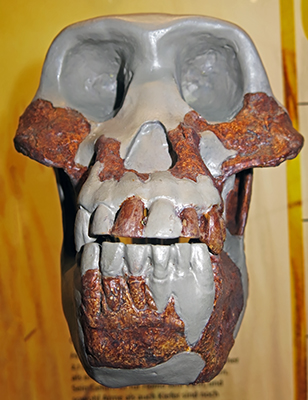
This is a facsimile of Australopithecus afarensis, which is similar in many ways to
Australopithecus bahrelghazali, and many researchers think that Australopithecus bahrelghazali is in fact better identified as Australopithecus afarensis.
Australopithecus bahrelghazali is the only Australopithecus found outside East Africa. Found at Koro-Toro, It is named after the Bahr-el-Ghazal oasis in Chad. Dated circa 3 500 000 BP.
Australopithecus bahrelghazali is an extinct species of australopithecine discovered in 1995 at Koro-Toro, Bahr el Gazel, Chad, existing around 3.5 million years ago in the Pliocene. It is the first and only australopithecine known from Central Africa, and demonstrates that this group was widely distributed across Africa as opposed to being restricted to East and southern Africa as previously thought.
Photo: Don Hitchcock 2015
Source: Facsimile, Vienna Natural History Museum, Naturhistorisches Museum Wien
Text: Adapted from Wikipedia
The validity of Australopithecus bahrelghazali has not been widely accepted, in favour of classifying the specimens as Australopithecus afarensis.
Australopithecus afarensis is a better known Pliocene australopithecine from East Africa, and the doubts over naming are because of the anatomical similarity and the fact that Australopithecus bahrelghazali is known only from 3 partial jawbones and an isolated premolar.

A well at Koro-Toro in Chad.
Photo: Gerhard Holub
Permission: Creative Commons Attribution-Share Alike 4.0 International license.
The Australopithecine, KT-12/H1, but known as 'Abel', inhabited a lakeside grassland environment with sparse tree cover, possibly similar to the modern Okavango Delta, and similarly predominantly ate C4 savanna foods—such as grasses, sedges, storage organs, or rhizomes—and to a lesser degree also C3 forest foods—such as fruits, flowers, pods, or insects. However, the teeth seem ill-equipped to process C4 plants, so its true diet is unclear.
Text above: Adapted from Wikipedia
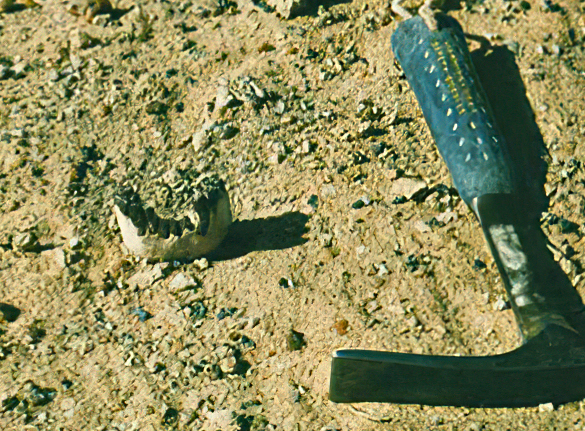
The fossil Abel as found at the time of discovery, 08:45 on 23 January 1995
The jaw fragment was found at the edge of a shallow gully exposing a mixture of coarse sand, gravel and small fragments of ironstone. The ground surface at the site is constituted of 5 cm of detrital deposits washed down slope by flowing water and then subjected to the action of wind. At KT 12, the slope of the land and the occurrence of violent rain storms at irregular intervals result in severe fluvial erosion.
Photo: Alain Beauvilain
Source: Beauvilain (2008)

General view of the site KT 12 in April 1998.
Photo: Alain Beauvilain
Source: Beauvilain (2008)
Australopithecus bahrelghazali ('Abel) discovered at KT12 by Mamelbaye Tomalta, January 23, 1995 (Alain Beauvilain, photographs of January 26, 1995, after the original, reserved rights), dated around 3.5 million years.
The dark brown color of teeth is due to the minerals present in the geological layer that stained the enamel during fossilisation.
The size of canine, barely longer than the adjacent teeth, and the absence of diastema (space existing in all monkeys between canines and bicuspids for receiving the protruding portion of the opposite canine) are the criteria for humanisation. The incisor of quasi-human form and the profile of the mandibular symphysis is almost vertical, as is the chin in humans, indicating a relatively flat surface. On the other hand, the presence of three roots of the premolars (one in man today, sometimes two, rarely three) is rather a primitive character.
The wear facets of teeth indicate permanent teeth of a young adult. The horizontal stripes visible on the base of the teeth are dysplasias due to a defect in the mineralization of enamel during the growth of the teeth due to a dietary deficiency or disease. Abel would have had such problems at least twice as evidenced by the two canine dysplasia. Given the context, Abel may have had hunger during droughts, causing dietary deficiencies and thus defects in the enamel.
X-rays revealed a thick enamel, human in nature, while in monkeys, it is thinner.
Photo: Alain Beauvilain
Source: https://chadcradlehumanity.monsite-orange.fr/page-577261ba4b7dc.html
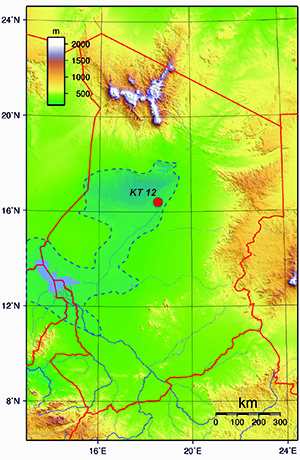
Location of the Koro-Toro site 12, the Australopithecus bahrelghazali place of discovery. The area limited by a blue dashed line refers to the inferred maximum extension of the Holocene Lake Mega Chad.
Photo: Chartep
Permission: Creative Commons Attribution-Share Alike 4.0 International license.
Australopithecus africanus
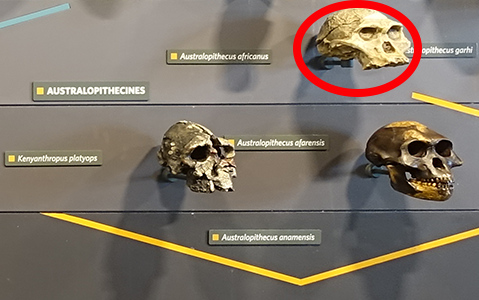
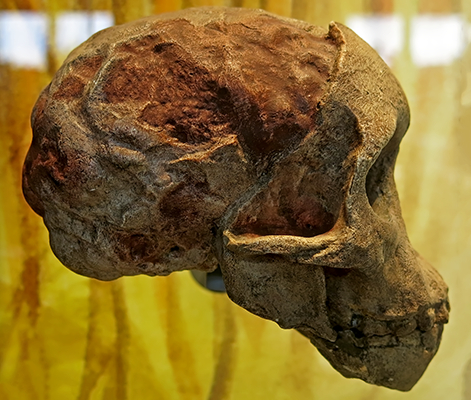
Australopithecus africanus, Taung child.
Circa 2 300 000 BP
Cranial fragments and endocast, TAUNG 1, South Africa.
The Taung Child is a partial skull and brain endocast discovered in 1924 in Taung, South Africa by Raymond Dart. This 2.3 million-year-old skull of a young child is the 'type specimen' or official representative of this species. It was the first fossil of a human ancestor ever found in Africa and was also the first to be classified in the genus Australopithecus. We know this individual was a young child because its first molar teeth were in the process of erupting from the jaw.
Photo: Don Hitchcock 2015
Source and text: Facsimile, Vienna Natural History Museum, Naturhistorisches Museum Wien
Additional text: https://australianmuseum.net.au/
Humans' distant ancestor Australopithecus africanus had a unique approach to raising their young, as shown in new research published in Nature.
Geochemical analysis of four teeth shows they exclusively breastfed infants for about 6-9 months, before supplementing breast milk with varying amounts of solid food until they were 5-6 years old. The balance between milk and solid food in this period varied cyclically, probably in response to seasonal changes in food availability.
This knowledge is useful on several fronts. From an evolutionary point of view, it helps us understand the particular biological and behavioural adaptations of Australopithecus africanus compared to other extinct human ancestors and modern humans.
However, breastfeeding for up to 5-6 years is metabolically expensive – it requires a certain input of calories for the lactating mother. Using milk as a supplemental food for older offspring may have hampered the ability of the A. africanus species to successfully survive during a period of substantially changing climate.
Perhaps this way of life hastened the extinction of A. africanus around 2 million years ago.
Photo and text: Luca Fiorenza, https://theconversation.com/, at https://tinyurl.com/y4n2xjlk
This is the most complete skull of Australopithecus africanus ever found. It had a shorter face than the Australopithecus afarensis species, and strong cheekbones to support large chewing muscles. Its brain was similar in size to that of modern apes such as chimpanzees.
Sterkfontein, South Africa
Photo: Don Hitchcock 2018
Catalog: STS5, PA EM 4377
Source: Facsimile, display at The Natural History Museum, Cromwell Road, London
Original: in the Maropeng Museum, South Africa
Australopithecus garhi

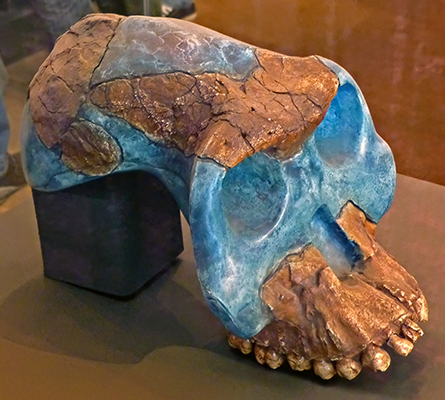
Australopithecus garhi
Circa 2 500 000 BP
The type specimen (BOU-VP-12/130) is a partial cranium discovered in 1997 by Yohannes Haile-Selassie in Bouri, Ethiopia. A second cranium, lower jaws and a partial skeleton have been found at nearby sites. These may represent the same species, however the discoverers point out that the skeletal remains need not belong to the same species as the skulls. This species was announced in 1999.
Brain size about 450 cc, similar to other australopithecines. Body size and shape probably slightly larger than A. afarensis. Very large canines, molars and premolars, thick tooth enamel, rectangular or U-shaped dental arcade diastema (gap between canines and incisors) often present in the upper jaw. This is a primitive feature. Like many australopithecines, including some A. afarensis, it has a sagittal crest for anchoring large jaw muscles
A changing climate had thinned the forests that once dominated this region, and savannah grasslands were becoming widespread.
It most likely ate plant material and possibly some meat. If the antelope bones found at the site were butchered by this species, then they must have included significant amounts of meat and marrow in their diet.
The skeletal remains were found associated with antelope bones bearing cut marks, apparently from stone tools. Stone tools were not found at this site, but at the nearby, contemporaneous site Gona. These are the earliest dated stone tools that have been found, but may have been left by another species.
The term Oldowan for choppers is taken from the site of Olduvai Gorge in Tanzania, where the first Oldowan stone tools were discovered by the archaeologist Louis Leakey in the 1930s.
It is not known for sure which hominin species created and used Oldowan tools, but its emergence is often associated with Australopithecus garhi.
Photo: Ji-Elle
Permission: Creative Commons Attribution-Share Alike 3.0 Unported licence
Text: Adapted from https://australianmuseum.net.au/
Additional text: Wikipedia
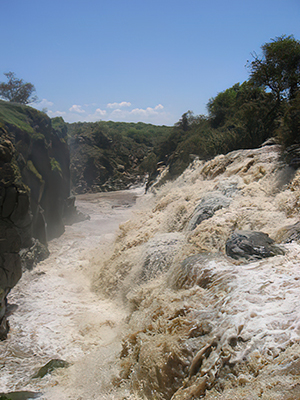
The Bouri 'peninsula' is a geological fault-raised horst that diverts the Awash River, forming a partial dam and creating Lake Yardi. It contains the Bouri Formation. The peninsula is about 4 km wide by 10 km long, and lies in a NNW-SSE direction in the Quaternary-period rift zone in the southern part of the Afar Depression (Afar Triangle).
Photo: Bjørg Sandkjær
Permission: Creative Commons Attribution ShareAlike license versions 2.5, 2.0, and 1.0
Text: Wikipedia
Australopithecus aethiopicus
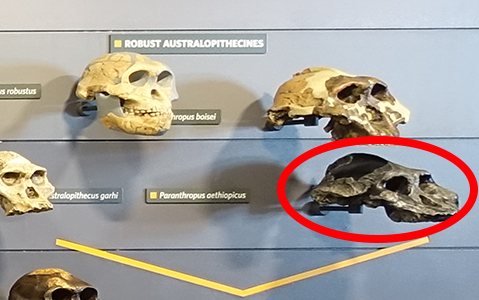
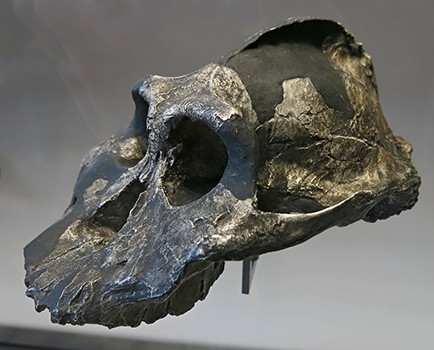
Paranthropus aethiopicus / Australopithecus aethiopicus, KNM-WT 17000.
Circa 2 500 000 BP.
Cranium with no lower jaw, West Turkana, Kenya. Known as the 'Black Skull' due to the dark coloration of the bone, caused by high levels of manganese in the deposit.
The skull is dated to 2 500 000 BP, older than the later forms of robust australopithecines. Anthropologists suggest that Australopithecus robustus lived between 2 700 000 BP and 2 500 000 BP. The features are quite primitive and share many traits with Australopithecus afarensis, thus Australopithecus aethiopicusis likely to be a direct descendant. As well as its face being as prognathic (projecting) as Australopithecus afarensis, its brain size was also quite small at 410 cm3
Photograph: Don Hitchcock 2015
Source and text: Facsimile, Vienna Natural History Museum, Naturhistorisches Museum Wien
Additional text: Wikipedia
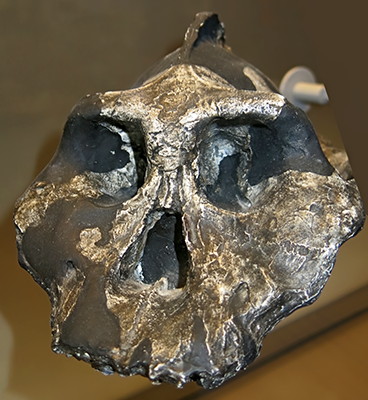
Paranthropus aethiopicus / Australopithecus aethiopicus, KNM-WT 17000.
Circa 2 500 000 BP.
Cranium with no lower jaw, West Turkana, Kenya.
Paranthropus aethiopicus is considered a megadont archaic hominin, the term megadont referring to the huge size of the postcanine tooth crowns. The initial discovery was a toothless adult mandible in the Shungura formation of the Omo region of Ethiopia in 1967 (Omo 18.18). The ash layers above and below the fossils give an approximate date of 2 500 000 BP - 2 300 000 BP. There is only one mostly complete skull for this hominin, so it is hard to make proper inferences about physical characteristics. However, it can be said that the available skull is similar to Paranthropus boisei, although the incisors are larger, the face more prognathic (projecting), and the cranial base less flexed.
The Black Skull was discovered in 1985 in Kenya by Alan Walker.
Australopithecus aethiopicus has notable features that differ from the other robust australopithecines, including a larger zygomatic arch, extended ramus of the mandible, and a more prognathic face. These differences may have been developed during the evolution of aethiopicus, but it may also suggest that Australopithecus aethiopicus has a different phylogenetic history than Australopithecus robustus and Australopithecus boisei.
Photograph: Don Hitchcock 2015
Source and text: Facsimile, Vienna Natural History Museum, Naturhistorisches Museum Wien
Additional text: Wikipedia

Paranthropus aethiopicus / Australopithecus aethiopicus, type specimen, OMO 18-1967-18.
Circa 2 600 000 BP.
This lower jaw was discovered in 1967 by Camille Arambourg and Yves Coppens at the Omo River location, Omo Valley, Ethiopia.
Paranthropus aethiopicus was first proposed in 1967 to describe a toothless partial mandible (Omo 18) found in Ethiopia by French palaeontologists. Lower jaw and teeth fragments have been uncovered. Paranthropus aethiopicus had a large sagittal crest and zygomatic arch adapted for heavy chewing (as in gorilla skulls).
Not much is known about this species since the best evidence comes from the 'Black Skull' and this jaw. There is not enough material to make an assessment of how tall they were, but they may have been as tall as Australopithecus afarensis.
Photograph: Don Hitchcock 2015
Source and text: Facsimile, Vienna Natural History Museum, Naturhistorisches Museum Wien
Additional text: Wikipedia
Australopithecus boisei
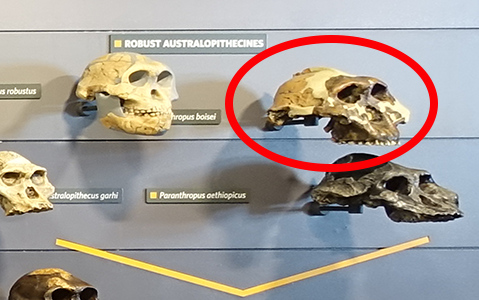
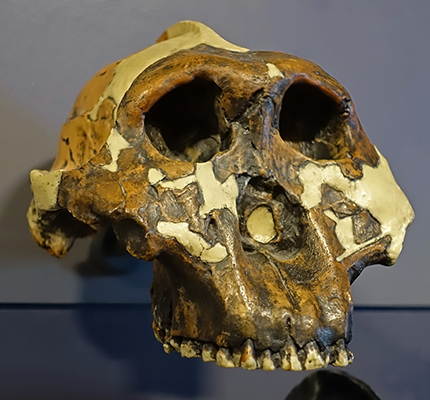
Paranthropus boisei
OH 5 (cranium)
Olduvai Gorge, Tanzania
1.8 million years BP
Discovered by M.D. Leakey, 1959
Facsimile
Photo: Don Hitchcock 2018
Source: Facsimile, display at The Natural History Museum, Cromwell Road, London
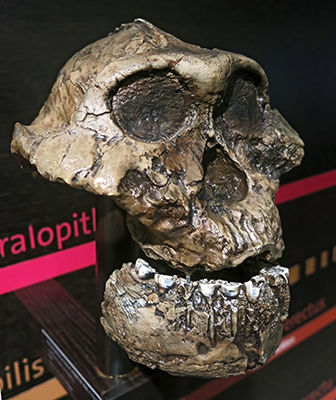
Paranthropus boisei / Australopithecus boisei, aka 'Nutcracker Man', KNM-ER 406, L7a-125, OH5, 1 700 000 BP.
Adult male with an estimated cranial capacity of 510 cc, from Koobi Fora, Kenya, Omo, Ethiopia
( note that this valuable facsimile includes the mandible, which is not present on other facsimiles of this particular find. It was not part of the original find, but was added from another fossil - Don )
Discovered in 1959 in Tanzania by Mary Leakey.
Koobi Fora refers primarily to a region around Koobi Fora Ridge, located on the eastern shore of Lake Turkana.
The ridge itself is an outcrop of mainly Pliocene/Pleistocene sediments. It is composed of claystones, siltstones, and sandstones that preserve numerous fossils of terrestrial mammals, including early hominin species. Presently, the ridge is being eroded into a badlands terrain by a series of ephemeral rivers that drain into the northeast portion of modern Lake Turkana. In 1968 Richard Leakey established the Koobi Fora Base Camp on a large sandspit projecting into the lake near the ridge, which he called the Koobi Fora Spit.
A subsequent survey and numerous excavations at multiple sites established the region as a source of hominin fossils shedding light on the evolution of man over the previous 4.2 million years. Far exceeding the number of hominin fossils are the non-hominin fossils which give a detailed view of the fauna and flora as far back as the Miocene.
KNM-ER 406 is a nearly complete adult male Paranthropus boisei. It has the facial and cranial features typical of the species such as massive cheek teeth, and the widely flaring zygomatic arches with a forward placed connection to the other facial bones, and large cheek bones supported powerful chewing muscles - the latter two features giving it a 'dish-shaped' face. Other muscles extended from his jaw to the sagittal crest at the top of his head. The cranial capacity of this skull has been estimated at 510 cc.
Catalog: Australopithecus boisei, KNM-ER 406, L7a-125
Photo: Don Hitchcock 2015
Source and text: Facsimile, LVR-LandesMuseum Bonn, Germany
Additional text: Wikipedia, http://humanorigins.si.edu/evidence/human-fossils/fossils/knm-er-406
Australopithecus robustus

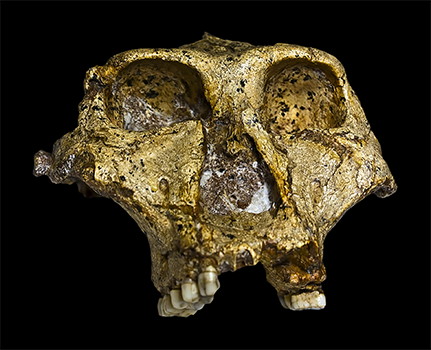
Australopithecus robustus / Paranthropus robustus
1 800 000 BP.
The original complete skull (without mandible) of Paranthropus robustus (SK-48 Swartkrans (26°00'S 27°45'E), Gauteng) was discovered in Kromdraai, South Africa.
Collection of the Transvaal Museum, Northern Flagship Institute, Pretoria South Africa.
Discovered by R. Broom and J.T. Robinson, 1947
The species Australopithecus robustus was first discovered and named by the eminent Dr. Robert Broom. Broom made a habit of buying fossil remains from a lime quarry worker, and on a particular visit on June 8, 1938, Broom bought a maxillary fragment containing a first molar. The shape and the size of the molar convinced Broom that this was a different species than Australopithecus africanus (Broom’s transvaalensis), and upon further investigation, found that the specimen had been found by a young boy who worked in the cave as a guide on Sundays. Broom searched for the boy (Gert Terblanche) and found him at school. Broom lectured the boy’s class on the cave sites of the area, and was then led to the place of the specimen’s discovery, Kromdraai. Broom found several more cranial and mandibular fragments associated with the original maxillary specimen, and this partial cranium (TM 1517) became the type specimen for Australopithecus robustus.
Particularly regarding cranial features, the development of Paranthropus robustus seemed to be in the direction of a 'heavy-chewing complex'. On account of the definitive traits associated with this 'robust' line of australopithecine, anthropologist Robert Broom established the genus Paranthropus and placed this species in it.
Paranthropus robustus is generally dated to have lived between 2.0 and 1.2 million years ago. It had large jaws and jaw muscles with the accompanying sagittal crest, and post-canine teeth that were adapted to serve in the dry environment they lived in.
Photo: José Braga, Didier Descouens
Permission: Creative Commons Attribution-Share Alike 4.0 International license. Not licensed for use on Facebook.
Text: Western Australian Museum, http://archaeologyinfo.com/australopithecus-robustus/
Australopithecus robustus
DNH 7, 'Eurydice'.
DNH 7 is the most complete skull of Paranthropus robustus ever discovered, and a rare female specimen from the Drimolen Main Quarry.
( Note that there is no obvious sagittal crest on this specimen - Don )
(left) Photo: Don Hitchcock 2018
(left) Source: Facsimile, display at The Natural History Museum, Cromwell Road, London
(right) Photo: Dr Herries, photographed at the University of the Witwatersrand
Permission: Creative Commons Attribution-Share Alike 4.0 International license
Text: Wikipedia
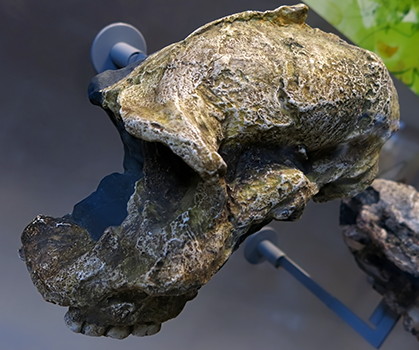
Australopithecus robustus
SK 46 is the fossilised partial cranium and palate of Australopithecus / Paranthropus robustus. It was discovered in Swartkrans, South Africa by local quarrymen and Robert Broom in 1949.
Circa 2 000 000 BP - 1 500 000 BP.
Photo: Don Hitchcock 2015
Source and text: Facsimile, Vienna Natural History Museum, Naturhistorisches Museum Wien
Additional text: Wikipedia
Australopithecus sediba
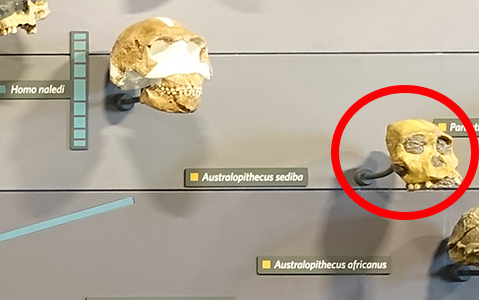
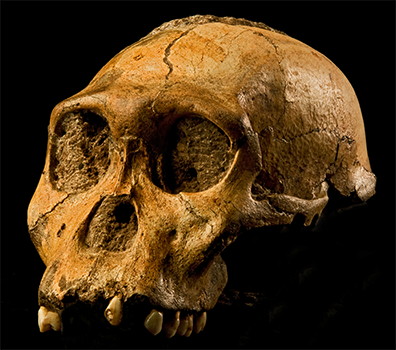
Australopithecus sediba
Cranium of the Malapa hominid 1 (MH1) from South Africa, named 'Karabo'. The combined fossil remains of this juvenile male is designated as the holotype for Australopithecus sediba.
Discovered in 2008 by Lee R. Berger.
Photo: Brett Eloff, Courtesy Profberger and Wits University
Permission: GNU Free Documentation License, Version 1.2 or any later version
Text: Wikipedia
Australopithecus sediba
Partial cranium, type specimen, MH1, circa 2 000 000 BP - 1 800 000 BP.
Malapa, South Africa
Photo: Don Hitchcock 2015
Source and text: Facsimile, Vienna Natural History Museum, Naturhistorisches Museum Wien
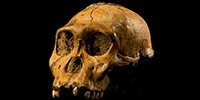
A more detailed page on Australopithecus sediba
Homo naledi
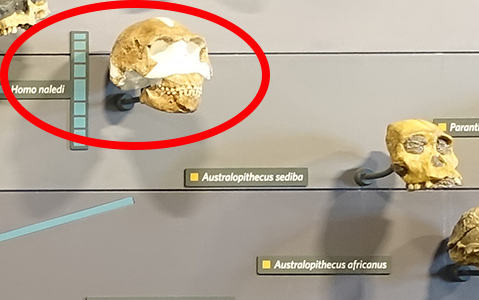

Homo naledi face reconstruction.
Photo: http://edition.cnn.com/videos/world/2015/09/10/human-ancestor-species-discovered-south-africa-mckenzie-pkg.cnn/video/playlists/ancient-discoveries/
and http://edition.cnn.com/2015/09/10/africa/homo-naledi-human-relative-species/index.html
Homo naledi is a previously-unknown species of extinct hominin discovered within the Dinaledi Chamber of the Rising Star cave system, Cradle of Humankind, South Africa. This species is characterised by body mass and stature similar to small-bodied human populations but a small endocranial volume similar to australopiths. Cranial morphology of Homo naledi is unique, but most similar to early Homo species including Homo erectus, Homo habilis or Homo rudolfensis.
While primitive, the dentition is generally small and simple in occlusal morphology. Homo naledi has humanlike manipulatory adaptations of the hand and wrist. It also exhibits a humanlike foot and lower limb. These humanlike aspects are contrasted in the postcrania with a more primitive or australopith-like trunk, shoulder, pelvis and proximal femur. Representing at least 15 individuals with most skeletal elements repeated multiple times, this is the largest assemblage of a single species of hominin yet discovered in Africa.
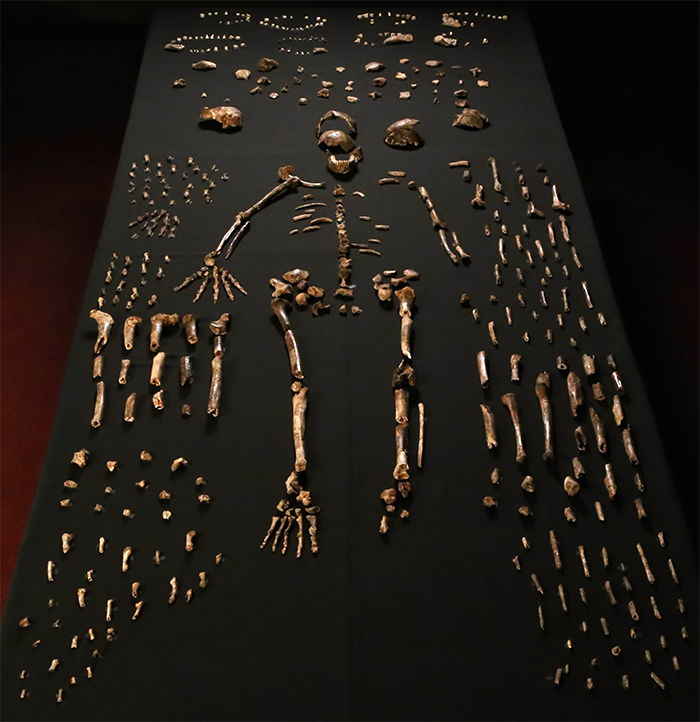
Homo naledi
Dinaledi skeletal specimens. The figure includes approximately all of the material incorporated in this diagnosis, including the holotype specimen, paratypes and referred material. These make up 737 partial or complete anatomical elements, many of which consist of several refitted specimens.
Specimens not identified to element, such as non-diagnostic long bone or cranial fragments, and a subset of fragile specimens are not shown here.
The 'skeleton' layout in the center of the photo is a composite of elements that represent multiple individuals. This view is foreshortened; the table upon which the bones are arranged is 120-cm wide for scale.
Source and text: http://elifesciences.org/content/4/e09560
Photo: © Lee Roger Berger research team
Permission: Creative Commons Attribution 4.0 International license.
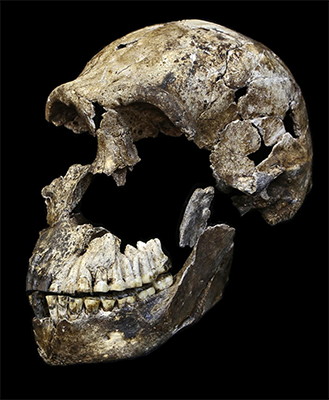
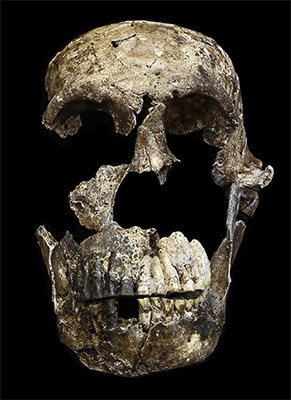
Homo naledi skull.
Photo: © National Geographic
Source: http://news.nationalgeographic.com/2017/05/homo-naledi-human-evolution-science/#/01_homo_naledi_update.jpg
Homo habilis
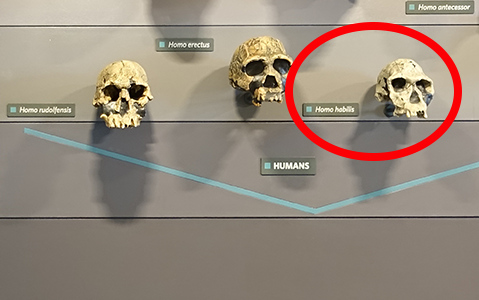

Forensic reconstruction of an adult female H. habilis by Élisabeth Daynès (2010), based on the KNM-ER 1813 cranium.
Homo habilis reconstruction in the Museo de la Evolución Humana, Burgos, sculpture by Elisabeth Daynes (2010) based on the KNM-ER 1813 cranium (Koobi Fora, Kenya, dated 1.9 Ma).
Photo: Own work (photograph); É. Daynès (sculpture) - Own work
Permission: CC BY-SA 4.0
Proximal Source: Wikipedia
Homo habilis was a species of the tribe Hominini, during the Gelasian and early Calabrian stages of the Pleistocene period, which lived between roughly 2.1 and 1.5 million years ago. The type specimen is OH 7, discovered in 1960 at Olduvai Gorge in Tanzania, associated with the Oldowan lithic industry; the fossils were identified as a separate species of Homo with the proposed binomial name of Homo Habilis('handy man') in 1964. In its appearance and morphology, Homo Habilis is the least similar to modern humans of all species in the genus Homo (except the equally controversial Homo rudolfensis ), and its classification as Homo has been the subject of controversial debate since its first proposal in the 1960s.
Text above: Wikipedia
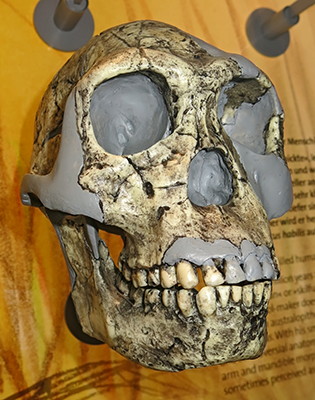
Homo habilis
Skull, KNM-ER 1813.
Discovered by Kamoya Kimeu at Koobi Fora, Kenya.
Circa 1 900 000 BP.
Photo: Don Hitchcock 2015
Source and text: Facsimile, Vienna Natural History Museum, Naturhistorisches Museum Wien
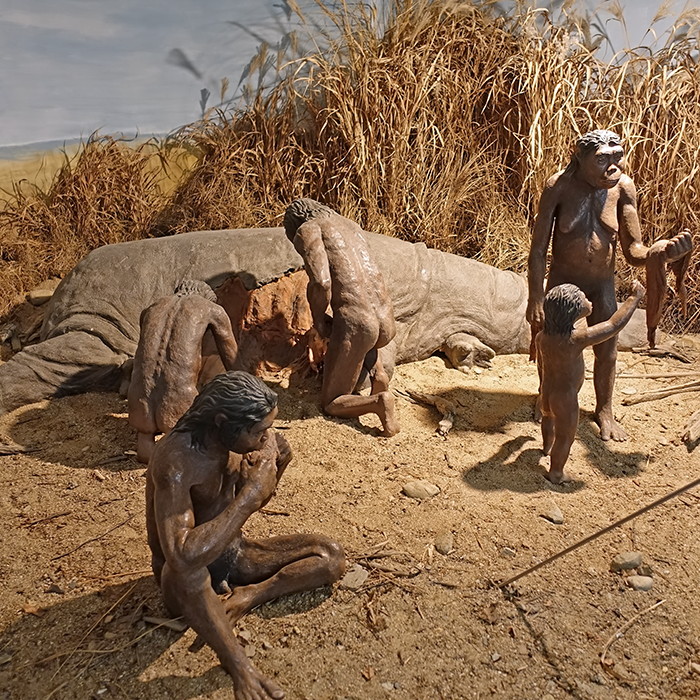
Diorama of Homo habilis at a dead hippo. It is a scientific reconstruction of the find of a specific situation from Lake Turkana in East Africa. The age of the find dates between 1.6 and 2 million years.
Homo habilis was not yet able to catch such a large animal as a hippo, and therefore in the drying environment of Africa, had a mostly herbal diet, supplemented by small animals and the found carcasses of dead animals.
Author diorama: Prof. Jan Jelínek
Artwork: Jan Jelínek ml. and Pavel Sabat
Photo: Don Hitchcock 2018
Source and text: Anthropos Pavilion/Moravian Museum, Brno, Czech Republic
Homo erectus - Homo ergaster
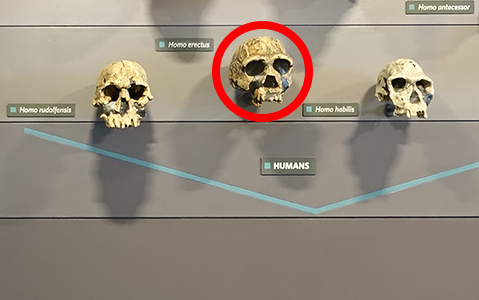
Note that Homo erectus and Homo ergaster are now considered by most researchers to be identical, although some consider ergaster to be the African form, and erectus to be the Asian form of essentially the same species.
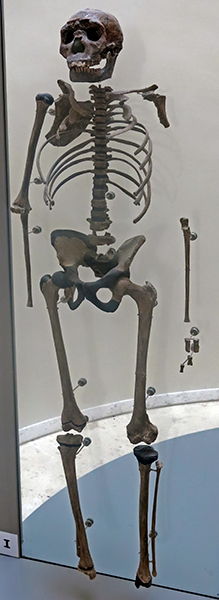
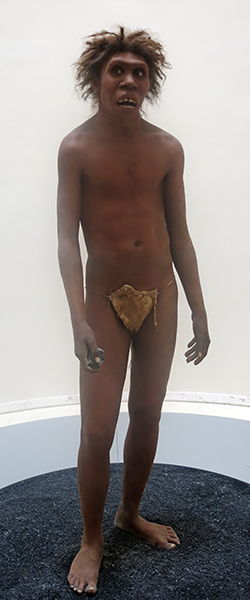
The most famous Homo erectus find is the 'Turkana Boy', KNM WT 15000, a young male discovered in Kenya by Kamoya Kimeu in 1984. The original is now kept at the Kenya National Museum.
His reconstructed skeleton - with a narrow pelvis and tall, thin body - is interpreted as showing adaptation to the hot climate and the need to run long distances.
In comparison, a new find from Gona (see: Homo erectus) is from a shorter female with a wider chest - a feature more commonly found now in humans from colder, even Arctic climates. The wide pelvis suggests the birth canal and brain size were co-evolving, as H. erectus adapted to the need to give birth to larger babies above the need to adapt to the pressure of external environmental factors.
Photo: Don Hitchcock 2014
Source: Display at Musée National de Préhistoire, Les Eyzies
Artist responsible for the hyperrealistic reconstruction of Turkana Boy: Elisabeth Daynès
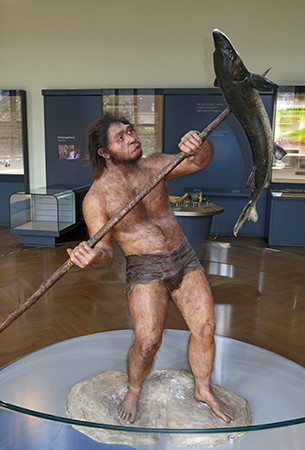
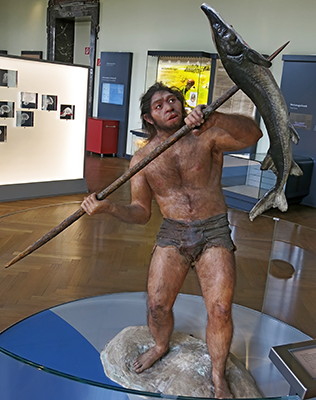
Homo erectus
Soft tissue reconstruction based on the skull reconstruction by G.J. Sawyer & I. Tattersall. They used the Zhoukoudian skull fragments XII, III, XIV/VI, X/I, X/II, the mandible fragments GI/II and the isolated teeth 2, 6, and 13.
Zhoukoudian, China, circa 780 000 BP - 600 000 BP.
Photo: Don Hitchcock 2015
Sculptor: Atelier Élisabeth Daynès, Paris
Source and text: Facsimile, Vienna Natural History Museum, Naturhistorisches Museum Wien
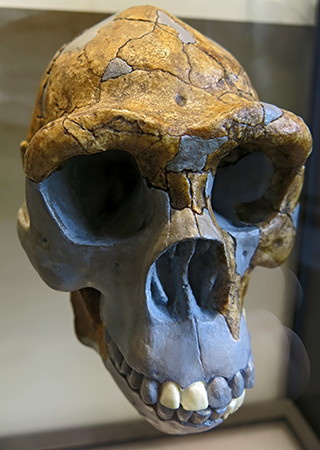
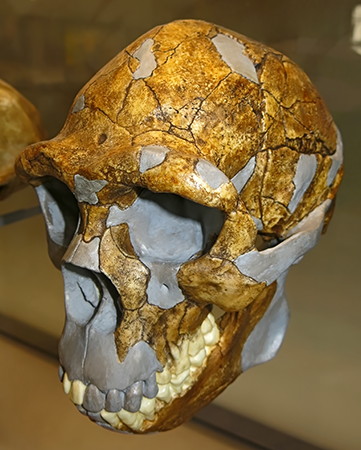
Homo erectus
Cranium, SKULL XII.
Circa 780 000 BP - 600 000 BP, Zhoukoudian, China.
Photo: Don Hitchcock 2015
Source and text: Facsimile, Vienna Natural History Museum, Naturhistorisches Museum Wien
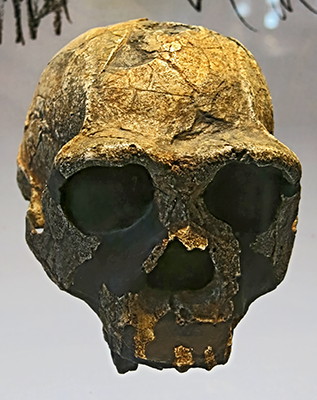
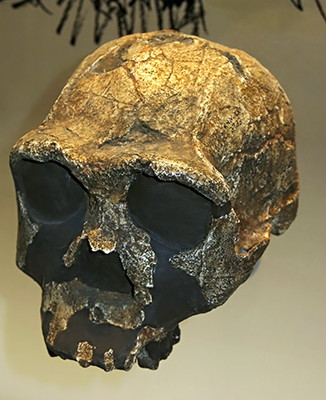
Homo ergaster
Cranium only, no lower jaw, KNM-ER 3733.
Koobi Fora, Kenya.
Circa 1 800 000 BP.
Photo: Don Hitchcock 2015
Source and text: Facsimile, Vienna Natural History Museum, Naturhistorisches Museum Wien

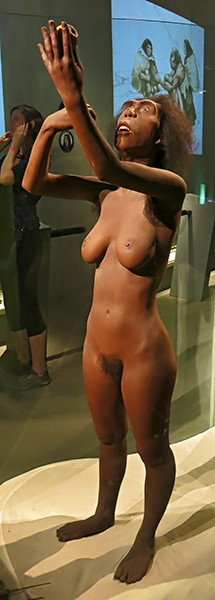
Homo erectus
Sculpture of the female from Koobi Fora, Kenya, probably KNM-ER 3733.
KNM-ER 3733 is a fossilised hominid cranium of the extinct hominid Homo ergaster, which is interchangeably referred to as Homo erectus. It was discovered in 1975 in Koobi Fora, Kenya, right next to Lake Turkana, by Bernard Ngeneo, a field worker for Richard Leakey. Its geographic location is not to be confused with that of KNM-WT 15000, Turkana Boy, also known as Nariokotome Boy, who was also found near Lake Turkana nine years later in 1984.
KNM-ER 3733 is one of the oldest Homo ergaster skulls in the world. Recent research using magnetostratigraphy has determined the age of KNM-ER 3733 to be circa 1 600 000 BP
KNM-ER 3733 is a find of a near-complete cranium. Its brain size is about 850 cm3. KNM-ER 3733 was compared to male fossils KNM-ER 3833 and KNM-WT 15000 (Turkana Boy), who were also found at the Koobi Fora site, and because of this, is said to be female. The features of KNM ER 3733 are less robust compared to the two male crania. It is considered to be an adult because of the extensive wear of its teeth, the fact that its third molars were present before the individual died, and because its cranial sutures were fully fused, which is only possible in an adult specimen.
Photo: Don Hitchcock 2015
Sculptor: Atelier Élisabeth Daynès, Paris, for the Neanderthal Museum, 1996.
Source and text: Facsimile, Neanderthal Museum, Mettmann, near Düsseldorf, Germany
Additional text: Wikipedia
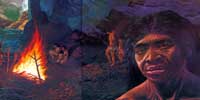
A more detailed page on Homo erectus (Beijing Man, Peking Man) sites
Homo rudolfensis
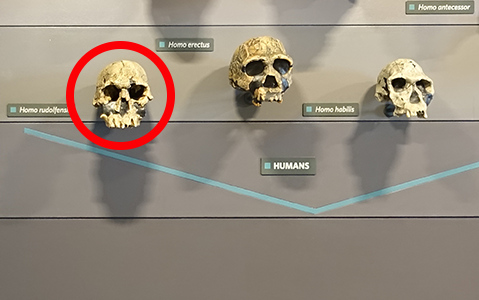
Homo rudolfensis - This early human lived about 2 million years ago, but its place on our family tree is debated.
Age: 2 400 000 BP to 1 800 000 BP.
The key specimen of this species is skull KNM-ER 1470. When it was discovered by Richard Leakey's team in 1972, it was not attributed to a species, only a member of the genus Homo. In 1986, a Russian anthropologist gave the skull the species name Pithecanthropus rudolfensis. The genus name of Pithecanthropus was later dropped and replaced with Homo.
Other cranial remains attributed to this species include the KNM-ER 1802, 1590, 1801 and 3732. Possible limb remains may include KNM-ER 1472 and 1481, but these were not found with skulls so attribution is questionable. The species name rudolfensis comes from the location where the type specimen KNM-ER 1470 was found - Lake Turkana, East Rudolph, Kenya. Fossils have been found in Urhara, Malawi, and Lake Turkana in Kenya.
Text above: http://australianmuseum.net.au/Homo-rudolfensis
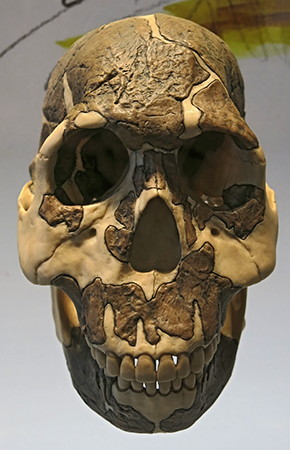
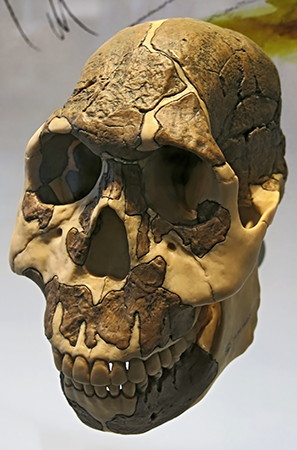
Homo rudolfensis type specimen from Koobi Fora, Kenya.
Skull, KNM-ER 1470.
Circa 2 000 000 BP - 1 900 000 BP.
Photo: Don Hitchcock 2015
Source and text: Facsimile, Vienna Natural History Museum, Naturhistorisches Museum Wien
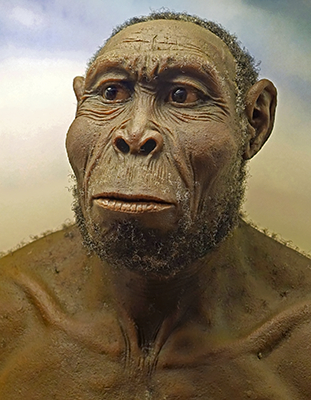
Homo rudolfensis reconstruction
Reconstruction: Wildlife Art
Photo: Daderot
Permission: This file is made available under the Creative Commons CC0 1.0 Universal Public Domain Dedication.
Source: Facsimile, Naturhistorisches Museum, Braunschweig, Germany

Homo rudolfensis
Hominid Corridor Research Project (HCRP): fossil mandible HCRP-UR 501 = Homo rudolfensis, original specimen, 2 400 000 BP, excavated by the German palaeo-anthropologist Friedemann Schrenk in Uraha, Malawi.
This photo was taken in Senckenberg-Museum, Frankfurt am Main, Germany. Hands of Elisabeth Vrba. UR 501 is the oldest known fossil of Genus Homo.
Photo: Gerbil
Permission: Creative Commons Attribution Share alike 3.0 Unported license.
Proximal source and text: Wikipedia
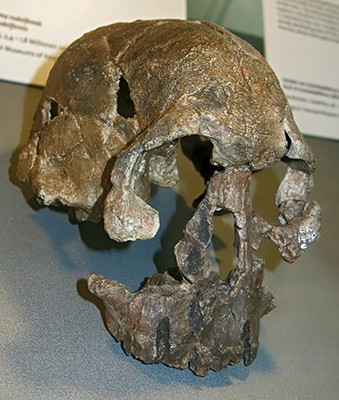
Skull of Homo rudolfensis
Discovered at Koobi Fora, Kenya, by B. Ngeneo, in 1972.
Circa 2 400 000 BP - 1 800 000 BP.
Photo: Don Hitchcock 2015
Source and text: Facsimile, Neanderthal Museum, Mettmann, near Düsseldorf
Homo antecessor

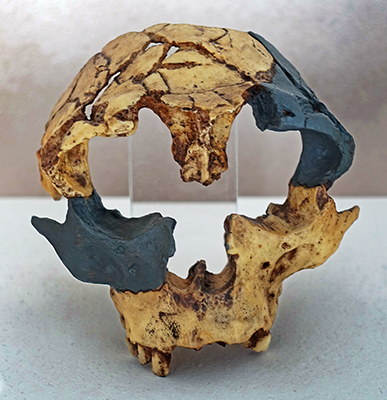
Homo antecessor
Cranial fragments from Gran dolina, Atapuerca, Spain.
Circa 780 000 BP
Fossils from the Gran Dolina railway cut in northern Spain's Sierra Atapuerca are from a hitherto unknown species of early human, according to the site's excavator José Bermúdez de Castro of the National Museum of Natural Sciences, Madrid, and his colleagues. They named the newly identified species Homo antecessor (from the Latin for pioneer or explorer), and claim that it is directly ancestral to both modern humans and Neanderthals. The Gran Dolina fossils - nearly 80 postcranial, cranial, facial, and mandibular bones as well as teeth of at least six individuals - were excavated between 1994 and 1996.
A key specimen is a partial facial skeleton of a juvenile, estimated to be ten to eleven years old, recovered in 1995. The fossils exhibit both seemingly modern features, such as sunken cheekbones with a horizontal rather than vertical ridge where upper teeth attach and a projecting nose and midface, and more primitive ones, including prominent brow ridges and premolars with multiple roots. The level in which the fossils were found, TD6, is dated by a reversal in the earth's magnetic field to more than 780 000 years ago. So far this level has been exposed only in a test pit of six square metres, but the excavators are confident that many more human fossils will be found when larger excavations reach the level some years in the future.
( The Australian museum at https://australianmuseum.net.au notes that although many experts consider these remains to be part of an early and variable Homo heidelbergensis population, the discoverers believe the fossils are different enough to be given a new species name Homo antecessor - Don )
Photo: Don Hitchcock 2018
Source: Anthropos Pavilion/Moravian Museum, Brno, Czech Republic
Text: Adapted from https://archive.archaeology.org/online/news/gran.dolina.html

Trinchera Galería, Atapuerca, Spain, where Homo antecessor was found during excavations for the Gran Dolina railway cut in northern Spain's Sierra Atapuerca.
Photo: Mario modesto
Permission: Creative Commons Attribution-Share Alike 3.0 Unported license.
Text: Wikipedia
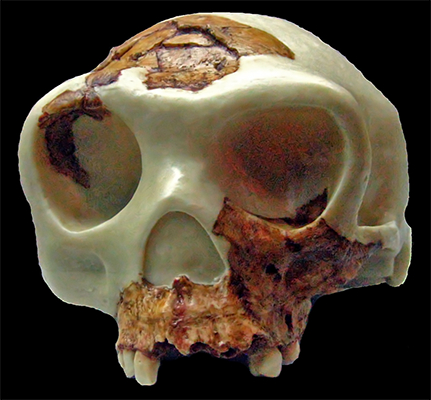
Reconstruction of Homo antecessor skull at Museu d'Arqueologia de Catalunya (Barcelona, Spain) Reconstrucción del cráneo de Homo antecessor, Museo de Arqueología de Cataluña (Barcelona, España).
Photo: Xvazquez
Source: Museu d'Arqueologia de Catalunya (Barcelona, Spain)
Text: Adapted from https://archive.archaeology.org/online/news/gran.dolina.html
Permission: Public Domain

Homo antecessor reconstruction, Museo de la Evolución Humana (Burgos, Spain).
Reconstruction by Élisabeth Daynès (2014), based on fragments from Gran Dolina, Atapuerca, Spain (ATD6-15, ATD6-96, ATD6-96), ca. 850 ka.
The reconstruction is that of an adolescent male of circa 10 years (the 'Boy of Gran Dolina').
Photo: Élisabeth Daynès
Source: Museu d'Arqueologia de Catalunya (Barcelona, Spain)
Text: Adapted from https://archive.archaeology.org/online/news/gran.dolina.html
Permission: GNU Free Documentation License, Version 1.2
Homo heidelbergensis
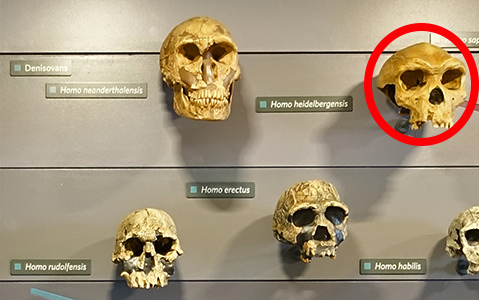
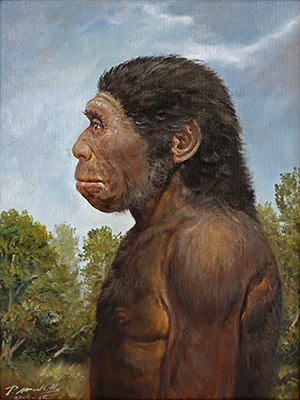
Portrait of Homo heidelbergensis.
Artist: Unknown
Photo: Don Hitchcock 2018
Source: Anthropos Pavilion/Moravian Museum, Brno, Czech Republic
Homo heidelbergensis mandible.
Mauer is the type site of Homo heidelbergensis.
This is Mauer 1, a lower jaw discovered in 1907 in Mauer, near Heidelberg, Germany. This jaw is the 'type specimen' or official representative of this species. It was discovered by workers at a gravel quarry which had previously yielded many fossils of extinct mammals. Lying at a depth of about 24 metres, its age is estimated to be between 400 000 and 600 000 years old.
This species had a strongly built lower jaw for the attachment of strong chewing muscles. As with earlier hominins, the lower jaw did not have a protruding, pointed chin. The teeth were arranged in the jaw so that they formed a parabolic shape (curved at the front then splayed out toward the back) and were smaller than those of earlier species (but larger than those of modern humans).
Text: Adapted from http://australianmuseum.net.au/image/Mauer-Jaw-Homo-heidelbergensis-angled-view/
Photo: Don Hitchcock 2014
Source: Facsimile, Museum of Geology and Palaeontology of the University of Heidelberg
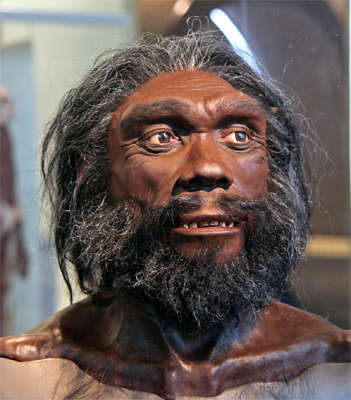
Model of the head and shoulders of an adult male Homo heidelbergensis on display in the Hall of Human Origins in the Smithsonian Museum of Natural History in Washington, D.C. created by John Gurche, a 'paleo-artist', who has recreated strikingly realistic heads of our earliest human ancestors.
Abigail Tucker, 'A Closer Look at Evolutionary Faces', Smithsonian.com, February 25, 2010 writes:
Appearing 700 000 years ago, Homo heidelbergensis is closely related to our own species. 'It has huge brow ridges,' Gurche notes. 'A lot of people think that’s kind of a shock absorber for the face, that it dissipates pressure put on teeth at the front of the skull, if you are using your mouth as a clamp to grip implements or a skin.'
Link: https://www.smithsonianmag.com/science-nature/a-closer-look-at-evolutionary-faces-8369070/
Photo: Tim Evanson
Permission: Creative Commons Attribution-Share Alike 2.0 Generic license.
Homo neanderthalensis
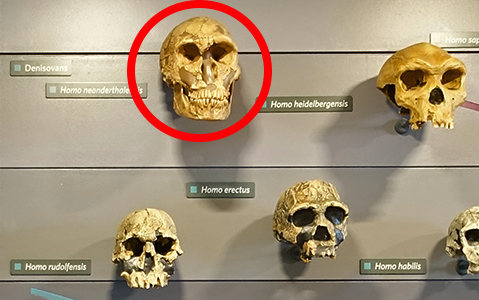

Homo neanderthalensis
A delightful cameo of the old man of La Chapelle-aux-Saints telling stories to a young child, by the master of the genre, Élisabeth Daynès.
(left) Soft tissue reconstruction based on the skeleton of a Neanderthal male (La Chapelle-aux-Saints 1, France), circa 50 000 BP
(right) Soft tissue reconstruction based on the fossil of a Neanderthal child (Gibraltar 2, Devil's Tower, UK), circa 50 000 BP - 30 000 BP.
Photo: Don Hitchcock 2015
Sculptor: Atelier Élisabeth Daynès, Paris
Source and text: Facsimile, Vienna Natural History Museum, Naturhistorisches Museum Wien

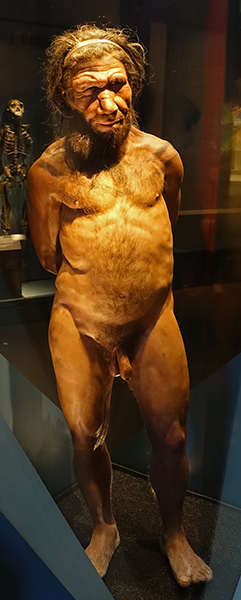
This Neanderthal man is based on the 40 000 BP remains found at Spy in Belgium, known as Spy2. He is naked to show his physique. However in the cold climate of the last glaciation, Neanderthals would have had to wear animal skins to survive.
Artist: Kennis & Kennis Reconstructions
Catalog: PA E 7787
Photo: Don Hitchcock 2018
Source and text: Facsimile, display at The Natural History Museum, Cromwell Road, London
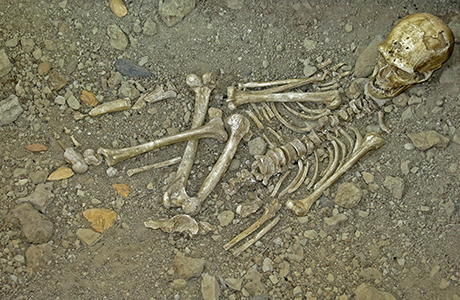
A recreation of the skeleton as found at Chapelle-aux-Saints.
Photo: Don Hitchcock 2014
Source: Facsimile, display at le musée de l'Homme de Néandertal, La Chapelle-aux-Saints
Homo neanderthalensis, type specimen, circa 40 000 BP
Kleine Feldhofer Grotte was a karstic limestone cave and a palaeoanthropologic site in the Neandertal Valley in western Germany. In August 1856, the Neanderthal type specimen was unearthed from the cave. Miners uncovered a skull cap and a number of skeletal bones to be labeled Neanderthal. The bones belong to at least three distinct individuals. Johann Carl Fuhlrott, a German schoolteacher, was the closest scientist to the scene in 1856. By the time Fuhlrott saw it, there was not much left but a few limb bones and the top of the skull, but the skullcap alone was enough to tell him that this was a different kind of human - low forehead, prominent brow ridges, and with sturdier bones than normal.
The cave was situated in a limestone gorge with the interior dimensions of 3 m (9.8 ft) in width by 5 m (16 ft) in length by 3 m (9.8 ft) in height, and a 1 m (3.3 ft) opening 20 m (66 ft) above the valley floor in the south wall which was 50 m (160 ft) high. The cave got its name from the nearby large farm of the Feldhof. The cave was completely destroyed during the 19th century as a result of industrial-scale limestone quarrying which widened the gorge. The location of the cave was soon forgotten and by 1900, unknown.
In 1997 a successful search for the site of the cave and its deposits yielded 24 fragments of human bone, one of which, identified as NN 13, fit exactly onto the left lateral femoral condyle of the Neanderthal 1 fossil. The 2000 excavation resulted in the recovery of thousands of artefacts. The mitochondrial DNA of two bone samples were fully sequenced, and completed in 2009.
The new specimens are all smaller and/or more fragmentary than the bones recovered in 1856. This is not surprising, because these specimens were thrown down an approximately 20 metre high rock face and subjected to breakage by subsequent quarrying activity while on the valley floor. Although fragmentary, many pieces of bone have been refitted to form more complete elements.
Photo: Don Hitchcock 2015
Source: Original bones of the type specimen of Homo neanderthalensis, displayed at LVR-LandesMuseum Bonn.
Text: Vienna Natural History Museum, Naturhistorisches Museum Wien
Additional text: Wikipedia
The skeleton of the original Neandertal.
Photo: Don Hitchcock 2018
Source: Original bones, apart from the skull, of the type specimen of Homo neanderthalensis, displayed at LVR-LandesMuseum Bonn.
 A page with a large number of links to the many Neanderthal skeletons and sites which have been found.
A page with a large number of links to the many Neanderthal skeletons and sites which have been found.
Denisovans / Homo sapiens denisova

The Denisovans or Denisova hominins are an extinct species or subspecies of archaic humans in the genus Homo. Pending its status as either species or subspecies, it currently carries the temporary names Homo sapiens [subspecies] denisova. In March 2010, scientists announced the discovery of a finger bone fragment of a juvenile female who lived about 41 000 years ago, found in the Denisova Cave in the Altai Mountains in Siberia, a cave that has also been inhabited by Neanderthals and modern humans. The mitochondrial DNA (mtDNA) of the finger bone showed it to be genetically distinct from Neanderthals and modern humans. The nuclear genome from this specimen suggested that Denisovans shared a common origin with Neanderthals, that they ranged from Siberia to Southeast Asia, and that they lived among and interbred with the ancestors of some modern humans, with about 3% to 5% of the DNA of Melanesians and Aboriginal Australians and around 6% in Papuans deriving from Denisovans.
A 2013 comparison with the genome of another Neanderthal from the Denisova cave revealed local interbreeding with local Neanderthal DNA representing 17% of the Denisovan genome, and evidence of interbreeding with an as yet unidentified ancient human lineage. Analysis of DNA from two teeth found in layers different from the finger bone revealed an unexpected degree of mtDNA divergence among Denisovans. Two teeth belonging to different members of the Denisova cave population have been reported. In November 2015, a tooth fossil containing DNA was reported to have been found and studied.
Denisovans and Neanderthals split from Homo sapiens around 600 000 up to 744 000 years ago and diverged from each other about 200 000 years later
Text above: Wikipedia
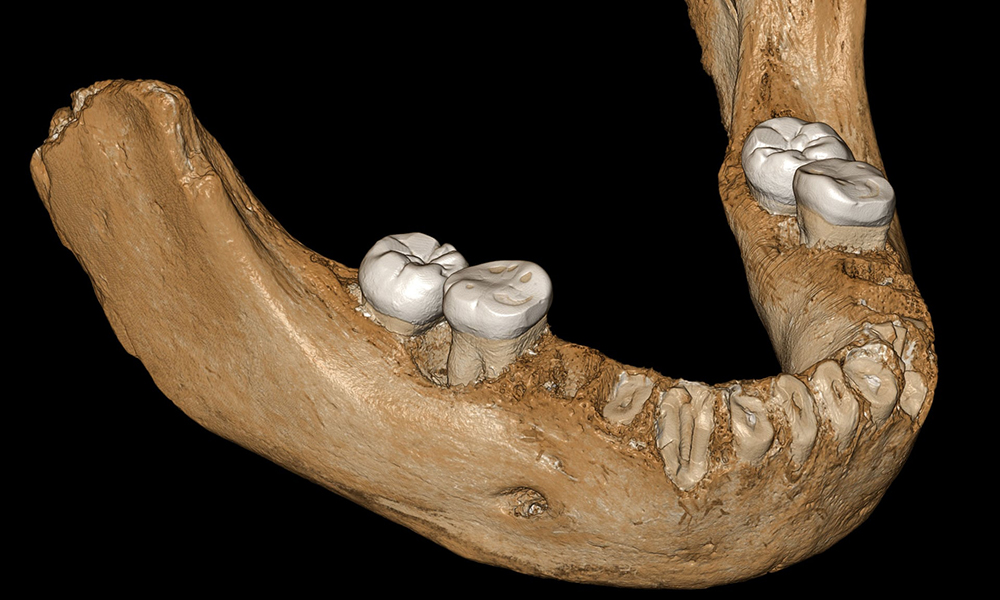
This Denisovan mandible likely represents the earliest hominin fossil on the Tibetan Plateau, researchers say.
Photo: Jean-Jacques Hublin/AFP/Getty Images
Source and text: Facsimile, https://www.theguardian.com/science/2019/may/01/denisovan-jawbone-discovered-in-tibetan-cave
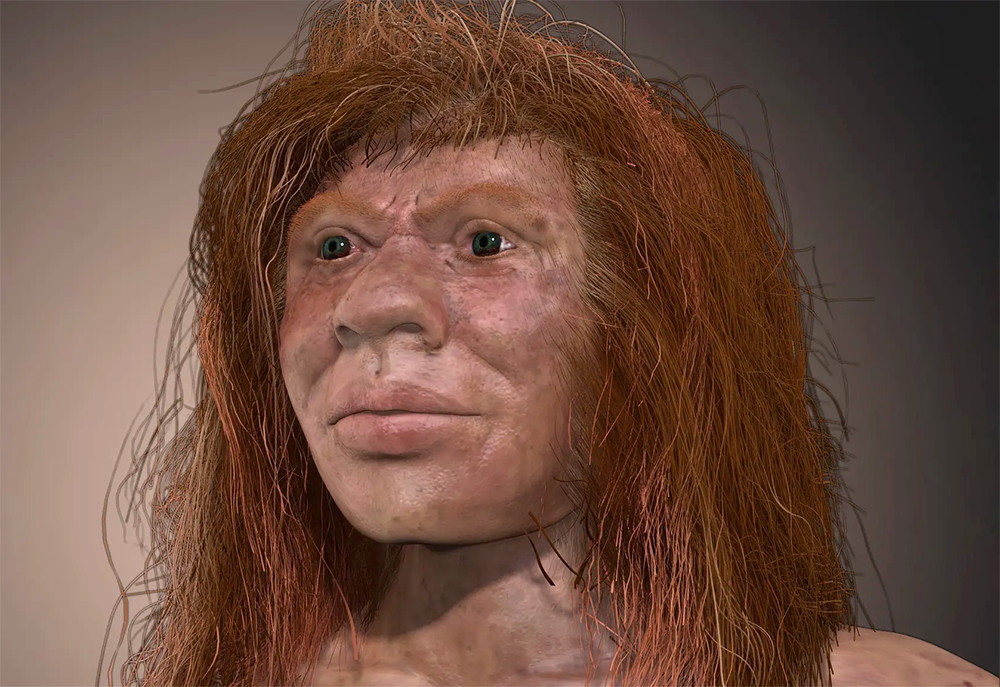
An artist’s impression of the teenage 'Denny', the ancient mixed heritage Denisovan mystery girl, who lived 90 000 years ago, and who had a Neanderthal mother and a Denisovan father.
Photo: © John Bavaro/early-man.com
Source and text: https://www.theguardian.com/science/2018/nov/24/denisovan-neanderthal-hybrid-denny-dna-finder-project
Homo floresiensis
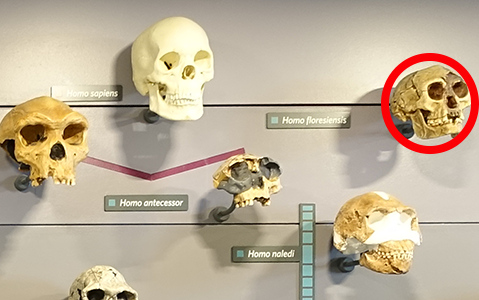
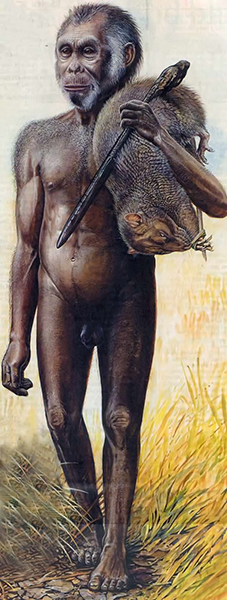
A painting of a male Homo floresiensis.
The story of man is being rewritten. Australian and Indonesian scientists have dug up skeletons of a previously unknown human species - real 'hobbits' that stood only a metre tall - that lived on the Indonesian island of Flores, west of Timor, until relatively recently.
The scientists found the first skeleton in September 2003 in Liang Bua, a large limestone cave on the island. The one-metre-tall female, aged about 30 and dubbed 'Hobbit', lived about 18 000 years ago.
Six similar skeletons were later found, some of whom lived in the cave just 13 000 years ago. The scientists have speculated that the species may have lived on Flores - which they dubbed the "lost world" - until the 16th century.
Artwork: Peter Schouten
Source and text: Stephen Cauchi Science Reporter, http://www.theage.com.au/articles/2004/10/27/1098667841536.html?oneclick=true
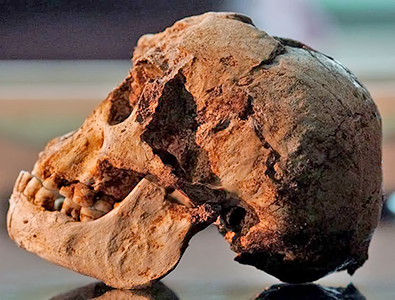
Homo floresiensis skull.
Photo: Reuters
Proximal source and text: http://www.abc.net.au/news/stories/2009/08/02/2643415.htm
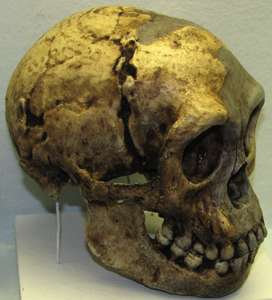

Resin cast of the skull and lower jaw of the 'Hobbit', donated to the UNE library by Professor Peter Brown.
Photo: Don Hitchcock 2009
Source: Facsimile, display at University of New England Library

Female Homo floresiensis
Homo floresiensis had a small brain, but stone tools found near its remains suggest that this species was a capable toolmaker. Standing at just over one metre tall, these people were one of the last human species to exist at the same time as ours.
This skeleton was found at Liang Bua, Flores, Indonesia, possibly 20 000 BP.
Catalog: LB1, PA EM 4377
Photo: Don Hitchcock 2018
Source and text: Facsimile, display at The Natural History Museum, Cromwell Road, London
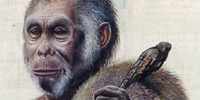 A more detailed page on Homo floresiensis, which was a one metre tall, human-like creature living and using tools in Indonesia just 18 000 years ago and was a distinct species, not just a malformed modern human. The so-called hobbit had wrist bones almost identical to those found in early hominins and modern chimpanzees, and so must have diverged from the human lineage well before modern humans and Neanderthals arose.
A more detailed page on Homo floresiensis, which was a one metre tall, human-like creature living and using tools in Indonesia just 18 000 years ago and was a distinct species, not just a malformed modern human. The so-called hobbit had wrist bones almost identical to those found in early hominins and modern chimpanzees, and so must have diverged from the human lineage well before modern humans and Neanderthals arose.
Homo luzonensis - the most recent living human relative
Homo luzonensis, is an extinct, possibly pygmy, species of archaic human from the Late Pleistocene of Luzon, the Philippines. Their remains, teeth, and phalanges, are known only from Callao Cave in the northern part of the island dating to before 50 000 years ago. They were initially identified as belonging to modern humans in 2010, but in 2019, after the discovery of more specimens, they were placed into a new species based on the presence of a wide range of traits similar to modern humans as well as to Australopithecus and early Homo.
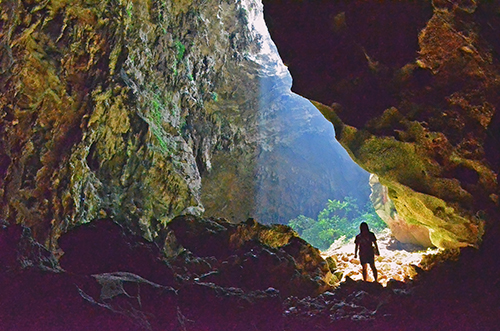
Callao Cave.
Photo: mkirader
Permission: Creative Commons Attribution 2.0 Generic license.
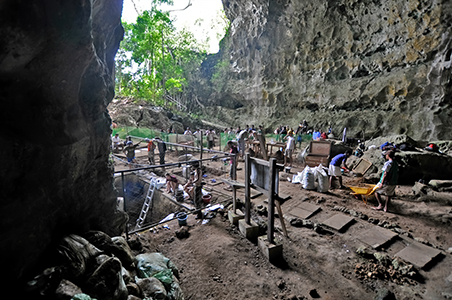
Excavations at Callao Cave.
In 2007, archaeologist Armand Salvador Mijares found a curious bone buried in Callao Cave in the Philippines island of Luzon. Shortly after, he and his colleagues concluded it was a third metatarsal from a human that lived some 67 000 years ago. Together with other findings, it demonstrated that humans could cross the open ocean and reach isolated islands very early on in our history.
But whether that bone belonged to Homo sapiens or another species of our genus was a mystery. Mijares, of the University of the Philippines, and his colleagues have since discovered twelve additional bones and teeth from the same site. Their analysis has revealed that the remains are unlike any other hominin fossils known, and likely represent a distinct species of the Homo genus. The researchers named it Homo luzonensis.
Photo: Callao Cave Archaeology Project.
Text: Katrina Zimmer, https://www.the-scientist.com/news-opinion/new-species-of-human--homo-luzonensis--identified-in-the-philippines-65722
The teeth of Homo luzonensis are consistent with the remains being assigned to a new species.
These are the right upper teeth of the Homo luzonensis individual CCH6. From left to right: two premolars and three molars.
Photo: Florent Détroit
Text and proximal source: https://www.bbc.com/news/science-environment-47873072
Additional text: https://www.businessinsider.com.au/anthropologists-welcome-new-species-homo-luzonensis-2019-4?r=US&IR=T
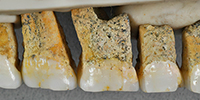 A more detailed page on Homo luzonensis is available here.
A more detailed page on Homo luzonensis is available here.
Homo sapiens
Modern Man
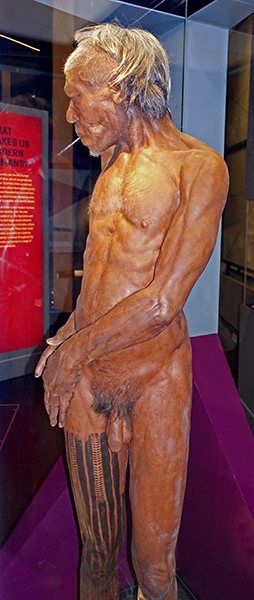

Homo sapiens
Modern Man
Early modern humans, both men and women, were taller and less stocky than Neanderthals, and perhaps more suited to endurance running rather than short powerful bursts of speed. Their body proportions were similar to people who live in hot conditions today.
Artist: Kennis & Kennis Reconstructions, based on humans living about 30 000 years ago.
Catalog: PA E 7788
Photo: Don Hitchcock 2018
Source and text: Facsimile, display at The Natural History Museum, Cromwell Road, London
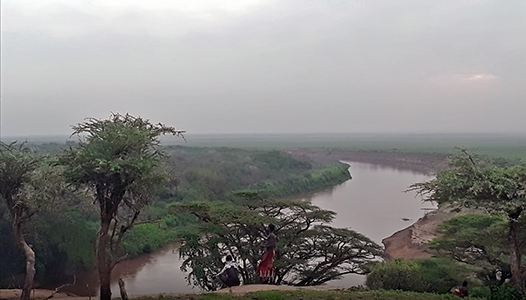
The Omo River at Kara Korcho village.
The Omo River in southern Ethiopia is the largest Ethiopian river outside the Nile Basin. Its course is entirely contained within the boundaries of Ethiopia, and it empties into Lake Turkana on the border with Kenya.
The lower valley of the Omo is currently believed by some to have been a crossroads for thousands of years as various cultures and ethnic groups migrated around the region. To this day, the people of the Lower Valley of the Omo, including the Mursi, Suri, Nyangatom, Dizi and Me'en, are studied for their diversity.
Photo: Melak Tadesse
Source: https://www.google.com/maps/
Additional text: Wikipedia
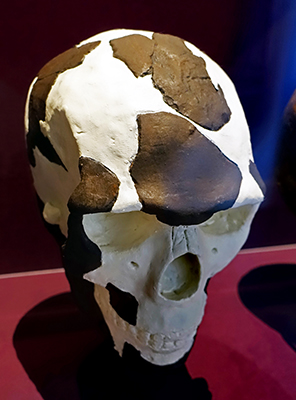
Early Homo sapiens
With its high, rounded braincase, this is one of the oldest modern human fossils found so far. Along with modern human skulls discovered in Herto, Ethiopia, it suggests that East Africa was a key area in the emergence of modern humans.
The Omo Kibish Formation or simply the Kibish Formation is a geological formation in the Lower Omo Valley of southwestern Ethiopia. Omo Kibish and the neighboring formations (Shangura and Usno) have produced a rich palaeoanthropological record with many hominin (e.g. Paranthropus boisei) and stone tool (e.g. Oldowan tools) finds dating to over millions of years. The Kibish formation, in particular, is most notable for Richard Leakey's work there in 1967 during which he and his team found one of the oldest remains of anatomically modern Homo sapiens. Known as Omo Kibish 1 (Omo I), the fossil is circa 196 000 years old and is among two other Omo remains (Omo II and Omo III) that were found in Member I of the Omo Kibish formation.
Catalog: Omo 1, PA EM 4400
Photo: Don Hitchcock 2018
Source and text: Facsimile, display at The Natural History Museum, Cromwell Road, London , the original fossil is kept in the National Museum of Ethiopia
Additional text: Wikipedia
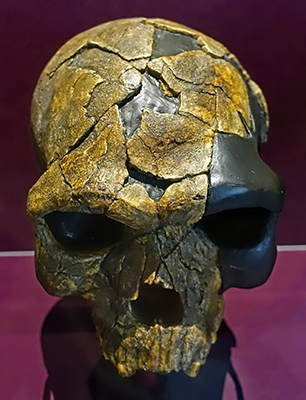
East African modern Homo sapiens
This large, robust skull was discovered in 2003 and has been dated to about 160 000 years ago. It is one of the oldest relatively complete modern human fossils ever found, and supports the idea of modern humans emerging in Africa, before migrating to the rest of the world.
Catalog: Bou-VP-16/1, PA EM 4401
Photo: Don Hitchcock 2018
Source and text: Facsimile, display at The Natural History Museum, Cromwell Road, London, the original fossil is kept in the National Museum of Ethiopia
Additional text: Wikipedia
Homo sapiens
Qafzeh Cave, Israel, 120 000 BP - 90 000 BP
This young adult's skull was found at a site in Israel. It provides some of the earliest fossil evidence of modern humans outside Africa. This individual was probably part of the first wave of modern human migration out of Africa.
( note that this wave towards Western Europe stalled at the Levant, probably died out there, or perhaps retreated back to Africa, and probably did not gain firm access to Western Europe until much later, perhaps 50 000 BP or later according to many researchers, but the matter is still in hot dispute. However modern humans may have gotten to Asia within this time frame, and there is evidence of Homo sapiens in Australia by around 60 000 BP - Don )
Catalog: Qafzeh 6, PA EM 4402
Source and text: Facsimile, display at The Natural History Museum, Cromwell Road, London , the original fossil is kept in the National Museum of Ethiopia
Original in Tel Aviv University, Israel
Homo sapiens
This modern human child, Qafzeh 11, was about 13 years old when he or she died. Their skull was found in a burial site with red deer antlers placed on the body. Intentional burial has also been documented in the Neanderthals.
From Qafzeh Cave, Israel, 90 000 - 120 000 years old.
It is believed that the Homo sapiens fossils found at Qafzeh Cave are from an early migration out of Africa by modern humans around 125 000 lyears ago. When this occurred, they must have encountered Neanderthal groups who were already living there.
Of special interest in this case is, first, the fact that it was at the bottom of the Mousterian sequence, a further indication that Homo sapiens made a number of efforts to migrate into the Levant from Africa, but for whatever reasons, was not successful at first.
Further, this child has now been found (Coqueugniot et al. 2014) to have had a healed trauma to the skull. The healing process led to a thin bone remodelling of the skull, the frailty of it explaining its post-mortem loss.
The child suffered a frontal bone depressed fracture, associated with brain damage. Furthermore the endocranial volume, smaller than expected for dental age, supports the hypothesis of a growth delay due to traumatic brain injury. This trauma did not affect the typical human brain morphology pattern of the right frontal and left occipital petalia. It is highly probable that this young individual suffered from personality and neurological troubles directly related to focal cerebral damage. Interestingly this young individual benefited from a unique funerary practice among the south-western Asian burials dated to the Middle Palaeolithic.
The adolescent was found in a pit dug in the bedrock. The skeleton was lying on its back, with the legs bent to the side and both hands placed on either side of the neck, and in the hands were the antlers of a large red deer clasped to the chest.
Photo: Don Hitchcock 2018
Sculptor of the recreation on the right: Kennis & Kennis Reconstructions
Source and text: Facsimile, The Natural History Museum, Cromwell Road, London
Additional text:
Coqueugniot et al. (2014) , the paper is available at https://journals.plos.org/plosone/article?id=10.1371/journal.pone.0102822
Additional text: Wikipedia
Original in the Tel Aviv University, Ramat Aviv, Israel
(left) LM3 - The oldest skeletal evidence of modern humans in Australia was found at Lake Mungo in the state of NSW. Lake Mungo 3 (LM3) was discovered by ANU geomorphologist Dr. Jim Bowler on 26 February 1974 when shifting sand dunes exposed the remains. LM3 was found near Lake Mungo, one of several dry lakes in the southeast part of the continent and 500 metres east of the LM1 site. The body had been laid out in great ceremony on its back, with knees bent and hands positioned at the groin with the fingers interlocked. Next to the body were the remains of fire. The body had been sprinkled with red ochre, in the earliest known example of such a sophisticated and artistic burial practice. This ritual burial aspect of the discovery has been particularly significant to Indigenous Australians, since it indicates that certain cultural traditions have existed on the Australian continent for much longer than previously thought.
Catalog: Facsimile, Mungo 3, PA EM 4403
(right) Kow Swamp 1 - This skull has larger and more robust features than the Lake Mungo skull. Modern humans may have developed physical differences as they dispersed across the Australian continent, adapting to their surroundings and continuing to evolve.
The Kow Swamp archaeological site comprises a series of late Pleistocene burials within the lunette of the eastern rim of a former lake known as Kow Swamp. The site is located 10 km south-east of Cohuna in the central Murray River valley, in northern Victoria, at 35.953553°S 144.318123°E. The site is significant for archaeological excavations by Alan Thorne between 1968 and 1972 which recovered the partial skeletal remains of more than 22 individuals.
Catalog: Facsimile, Kow Swamp 1, PA EM 4404
Photo: Don Hitchcock 2018
Source and text: display at The Natural History Museum, Cromwell Road, London
Additional text: Wikipedia
Mtoto
East African modern Homo sapiens.
Gemma Conroy writes (at https://www.abc.net.au) that the Middle Stone Age grave of a three year old child who lived 78 000 years ago has been found in a cave in Kenya. In a paper in the journal Nature, Martinón-Torres et al. (2021), the researchers who studied the fragile, ancient remains described how its head appeared to have been laid on a pillow. Scientists have named the child Mtoto, meaning 'child' in Swahili.
Photo: Computer graphic reconstruction by © Jorge González/Elena Santos
Proximal source and text: Gemma Conroy, https://www.abc.net.au/news/science/2021-05-06/oldest-human-burial-site-in-africa/100065050
General view of the cave site of Panga ya Saidi.
The international team of archaeologists carefully cast the entire grave in plaster in order to preserve the arrangement of surviving bone fragments. This enabled them to transport the body safely to a laboratory for detailed study.
The researchers were able to study the teeth to confirm that this was the tiny body of a human child - between two and three years old. Scans revealed that the body had been laid in a fetal position.
And the bones had moved in a way that suggested it had been wrapped tightly when buried, with its head originally resting on something like a cushion of leaves, which subsequently decomposed.
Photo: © Mohammad Javad Shoaee
Proximal source for the photo: Jessica Wapner,
https://www.newsweek.com/2018/06/01/enormous-cave-east-africa-shows-human-evolution-happened-gradually-and-942998.html
Text: Victoria Gill, https://www.bbc.com/news/science-environment-56986457
References
- Beauvilain, A., 2008: The contexts of discovery of Australopithecus bahrelghazali (Abel) and of Sahelanthropus tchadensis (Toumaï): unearthed, embedded in sandstone, or surface collected?, S. Afr. j. sci., online, 2008, vol.104, n.5-6, ISSN 1996-7489.
- Coqueugniot, H. et al., 2014: Earliest Cranio-Encephalic Trauma from the Levantine Middle Palaeolithic: 3D Reappraisal of the Qafzeh 11 Skull, Consequences of Pediatric Brain Damage on Individual Life Condition and Social Care, Plos One, July 23, 2014https://doi.org/10.1371/journal.pone.0102822
- Haile-Selassie, Y., 2001: Late Miocene hominids from the Middle Awash, Ethiopia, Nature, 412, 178-181.
- Heinrich, R. et al., 1993: Hominid radius from the middle Pliocene of Lake Turkana, Kenya, American Journal of Physical Anthropology, https://doi.org/10.1002/ajpa.1330920203
- Lebatard, A. et al., 2010:Application of the authigenic 10 Be/ 9 Be dating method to continental sediments: Reconstruction of the Mio-Pleistocene sedimentary sequence in the early hominid fossiliferous areas of the northern Chad Basin, Earth and Planetary Science Letters, 297(1):57-70 DOI: 10.1016/j.epsl.2010.06.003
- Martinón-Torres, M., d’Errico, F., Santos, E. et al., 2021: Earliest known human burial in Africa, Nature, 593, 95–100 (2021). https://doi.org/10.1038/s41586-021-03457-8
- Saylor, B. et al., 2019: Age and context of mid-Pliocene hominin cranium from Woranso-Mille, Ethiopia, Nature, August 2019, DOI: 10.1038/s41586-019-1514-7
- Martinón-Torres, M., d’Errico, F., Santos, E. et al., 2021: Earliest known human burial in Africa, Nature, 593, 95–100 (2021). https://doi.org/10.1038/s41586-021-03457-8
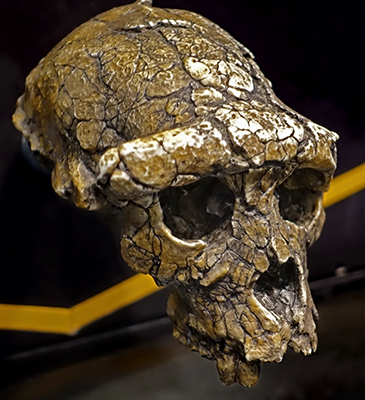
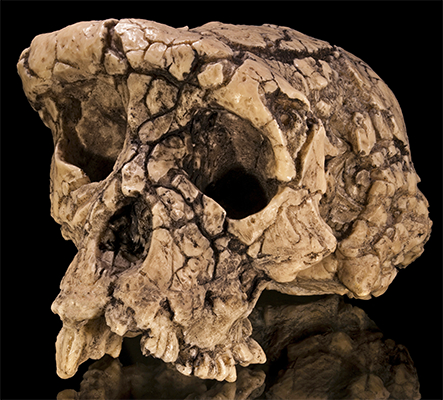
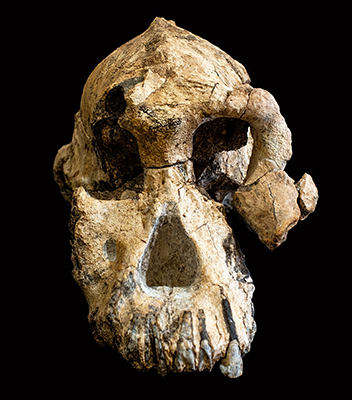

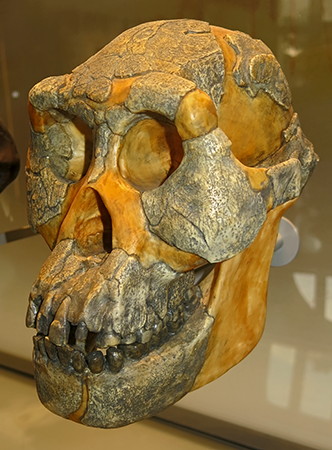
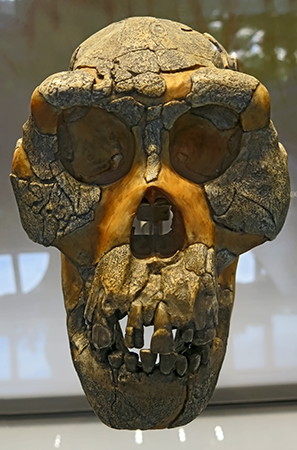
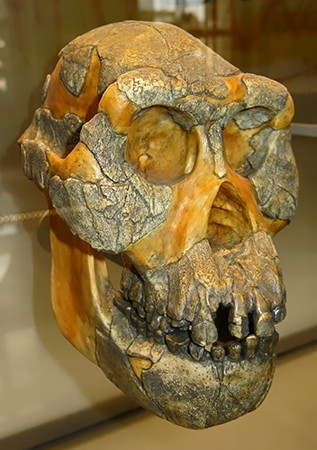
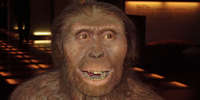 A more detailed page on Australopithecus afarensis, an extinct hominid that lived between 3.9 and 2.9 million years ago. .
A more detailed page on Australopithecus afarensis, an extinct hominid that lived between 3.9 and 2.9 million years ago. . 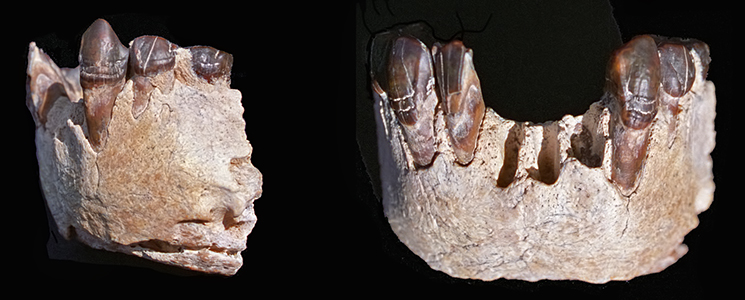
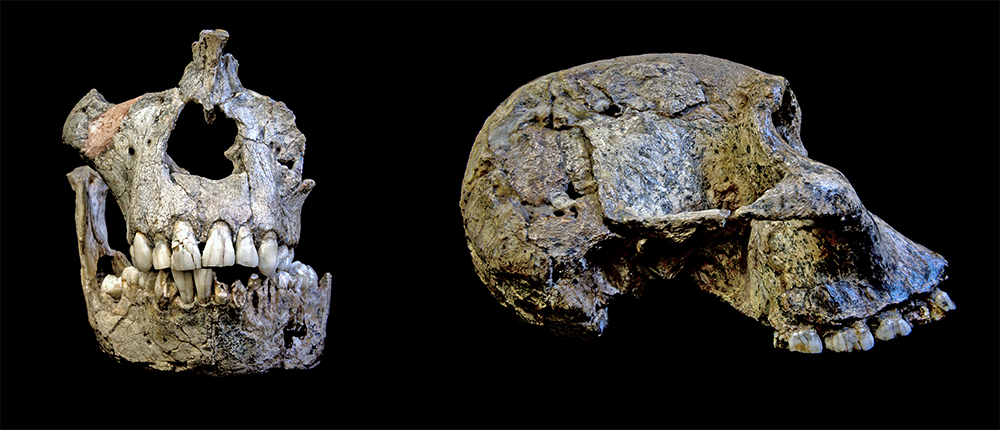
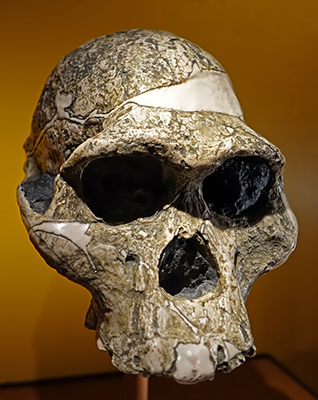
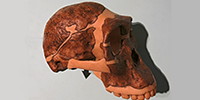 A more detailed page on Australopithecus africanus. In common with the older Australopithecus afarensis, Australopithecus africanus was of slender build, or gracile, and was thought to have been a direct ancestor of modern humans. Fossil remains indicate that Australopithecus africanus was significantly more like modern humans than Australopithecus afarensis, with a more human-like cranium permitting a larger brain and more humanoid facial features.
A more detailed page on Australopithecus africanus. In common with the older Australopithecus afarensis, Australopithecus africanus was of slender build, or gracile, and was thought to have been a direct ancestor of modern humans. Fossil remains indicate that Australopithecus africanus was significantly more like modern humans than Australopithecus afarensis, with a more human-like cranium permitting a larger brain and more humanoid facial features.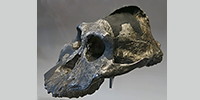 A more detailed page on Australopithecus aethiopicus, which is in the group known as the robust australopithecines. The robust australopithecines are split into three species, Australopithecus aethiopicus, Australopithecus robustus, and Australopithecus boisei. There has been an ongoing debate over the exact phyletic origins of each of these species. The robust australopithecines share many characteristics of the cranium and mandible, perhaps suggesting a shared evolutionary development.
A more detailed page on Australopithecus aethiopicus, which is in the group known as the robust australopithecines. The robust australopithecines are split into three species, Australopithecus aethiopicus, Australopithecus robustus, and Australopithecus boisei. There has been an ongoing debate over the exact phyletic origins of each of these species. The robust australopithecines share many characteristics of the cranium and mandible, perhaps suggesting a shared evolutionary development.
 A more detailed page on Australopithecus boisei, an early hominin. It lived in Eastern Africa during the Pleistocene epoch from about 2.3 until about 1.2 million years ago. It had a skull highly specialised for heavy chewing and several traits seen in modern day gorillas. It inhabited savannah woodland territories.
A more detailed page on Australopithecus boisei, an early hominin. It lived in Eastern Africa during the Pleistocene epoch from about 2.3 until about 1.2 million years ago. It had a skull highly specialised for heavy chewing and several traits seen in modern day gorillas. It inhabited savannah woodland territories.
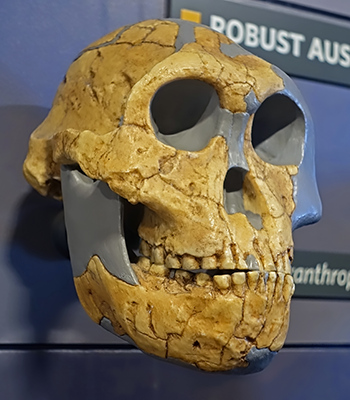
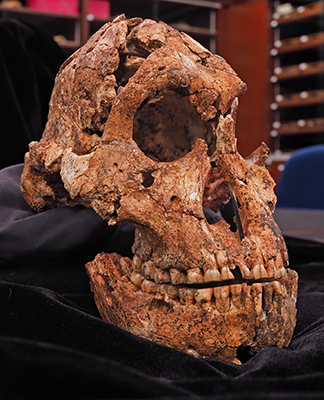
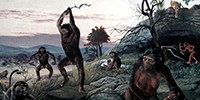 This is a more detailed page on Australopithecus robustus / Paranthropus robustus, which had a head shaped a bit like a gorilla, with a more massive built jaw and teeth in comparison to hominins within the Homo lineage. The sagittal crest on top of the skull acted as an anchor for large chewing muscles.
This is a more detailed page on Australopithecus robustus / Paranthropus robustus, which had a head shaped a bit like a gorilla, with a more massive built jaw and teeth in comparison to hominins within the Homo lineage. The sagittal crest on top of the skull acted as an anchor for large chewing muscles.

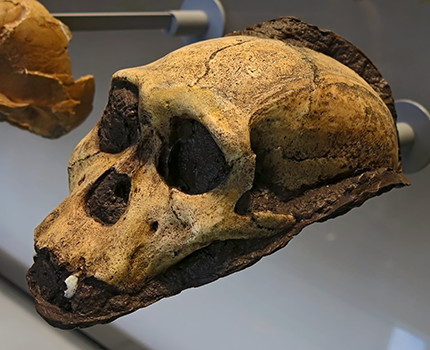
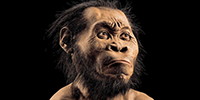 A more detailed page on Homo naledi. In 2013, fossil skeletons were found in a chamber of the Rising Star Cave system, about 50 km northwest of Johannesburg. Although archaic features of its skeleton resembled fossil specimens roughly two million years old, in 2017 the fossils were dated close to 250 000 years BP, and thus contemporary with larger brained anatomically modern humans, Neanderthals, and Denisovans.
A more detailed page on Homo naledi. In 2013, fossil skeletons were found in a chamber of the Rising Star Cave system, about 50 km northwest of Johannesburg. Although archaic features of its skeleton resembled fossil specimens roughly two million years old, in 2017 the fossils were dated close to 250 000 years BP, and thus contemporary with larger brained anatomically modern humans, Neanderthals, and Denisovans.
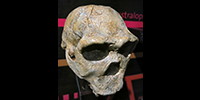 A more detailed page on Homo habilis, which was short and had disproportionately long arms compared to modern humans; however, it had a less protruding face than the australopithecines from which it is thought to have descended. H. habilis had a cranial capacity slightly less than half of the size of modern humans. Despite the ape-like morphology of the bodies, Homo habilis remains are often accompanied by primitive stone tools (e.g. Olduvai Gorge, Tanzania and Lake Turkana, Kenya).
A more detailed page on Homo habilis, which was short and had disproportionately long arms compared to modern humans; however, it had a less protruding face than the australopithecines from which it is thought to have descended. H. habilis had a cranial capacity slightly less than half of the size of modern humans. Despite the ape-like morphology of the bodies, Homo habilis remains are often accompanied by primitive stone tools (e.g. Olduvai Gorge, Tanzania and Lake Turkana, Kenya).
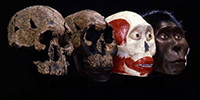
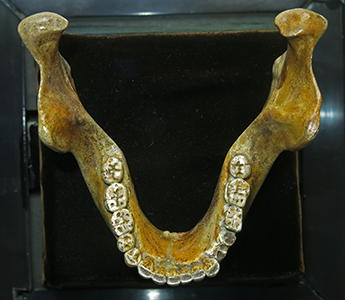
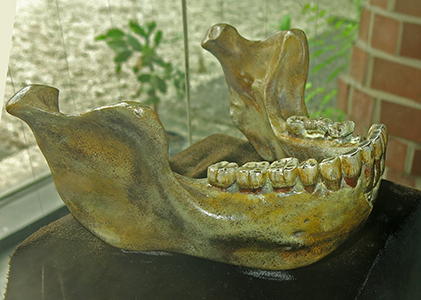
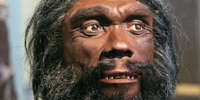 A more detailed page on Homo heidelbergensis which is an extinct species of the genus Homo which lived in Africa, Europe and western Asia from at least 600 000 years ago, and may date back 1 300 000 years. It survived until 200 000 to 250 000 years ago. It is probably the ancestor of Homo sapiens in Africa and the Neanderthals in Europe, and perhaps also the Denisovans in Asia.
A more detailed page on Homo heidelbergensis which is an extinct species of the genus Homo which lived in Africa, Europe and western Asia from at least 600 000 years ago, and may date back 1 300 000 years. It survived until 200 000 to 250 000 years ago. It is probably the ancestor of Homo sapiens in Africa and the Neanderthals in Europe, and perhaps also the Denisovans in Asia. 
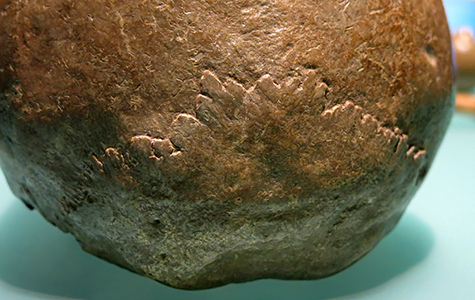
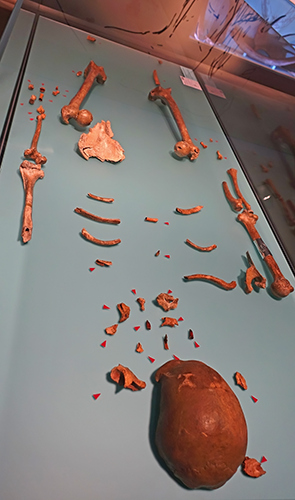
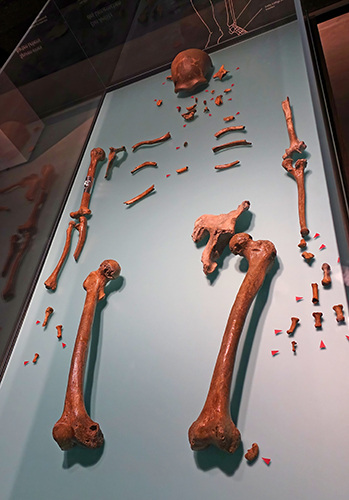
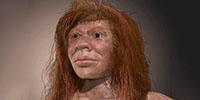 A more detailed page on the Denisovans. Up to 6% of the genes now found in modern New Guineans and 3-5% of the DNA of aboriginal Australians is made up of Denisovan DNA, scientists have discovered. The gene that allows Tibetan people to survive high altitudes is also believed to have been inherited from them.
A more detailed page on the Denisovans. Up to 6% of the genes now found in modern New Guineans and 3-5% of the DNA of aboriginal Australians is made up of Denisovan DNA, scientists have discovered. The gene that allows Tibetan people to survive high altitudes is also believed to have been inherited from them.
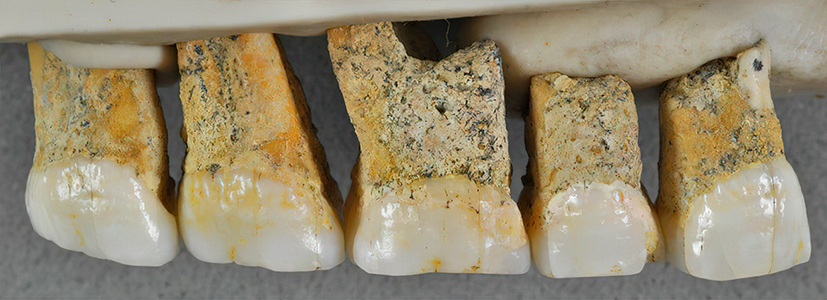
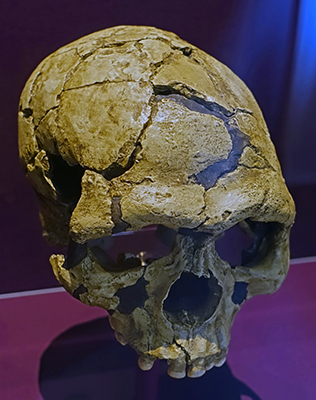
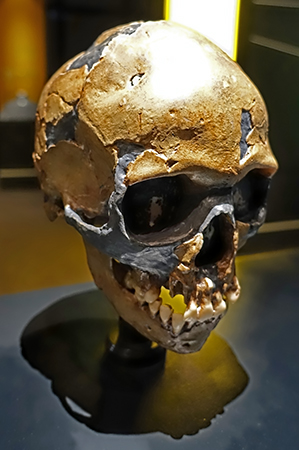
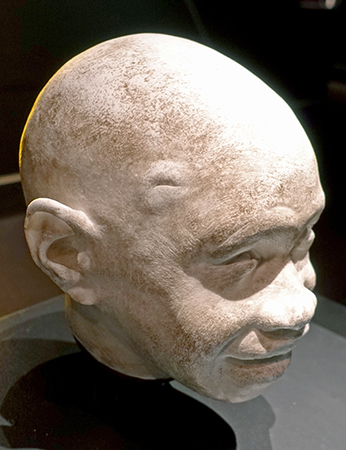
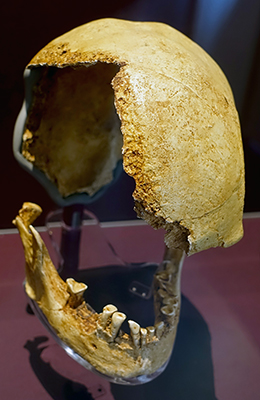
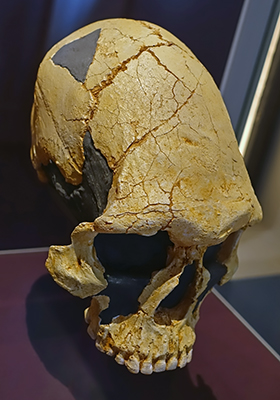
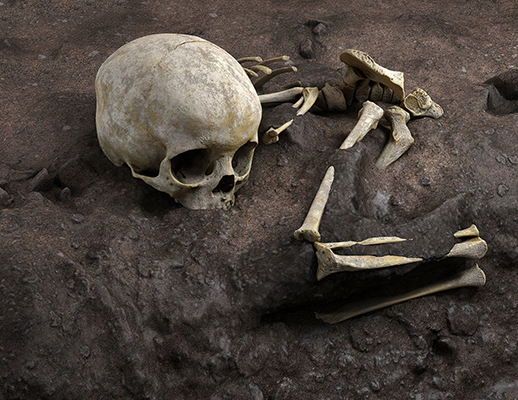
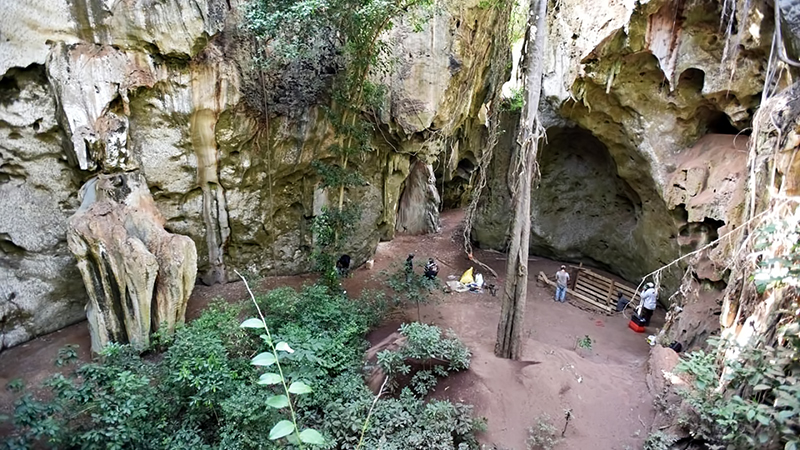
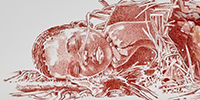 A more detailed page on the Middle Stone Age grave of Mtoto, a three year old Homo sapiens child who lived 78 000 years ago, found in a cave in Kenya.
A more detailed page on the Middle Stone Age grave of Mtoto, a three year old Homo sapiens child who lived 78 000 years ago, found in a cave in Kenya.